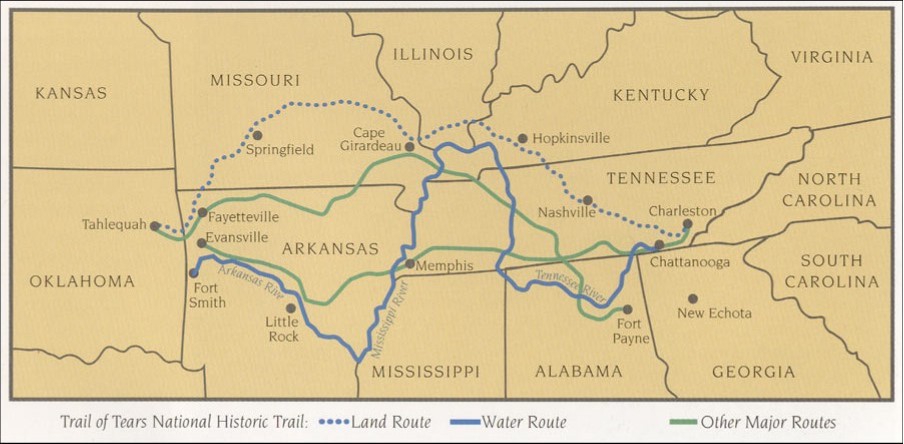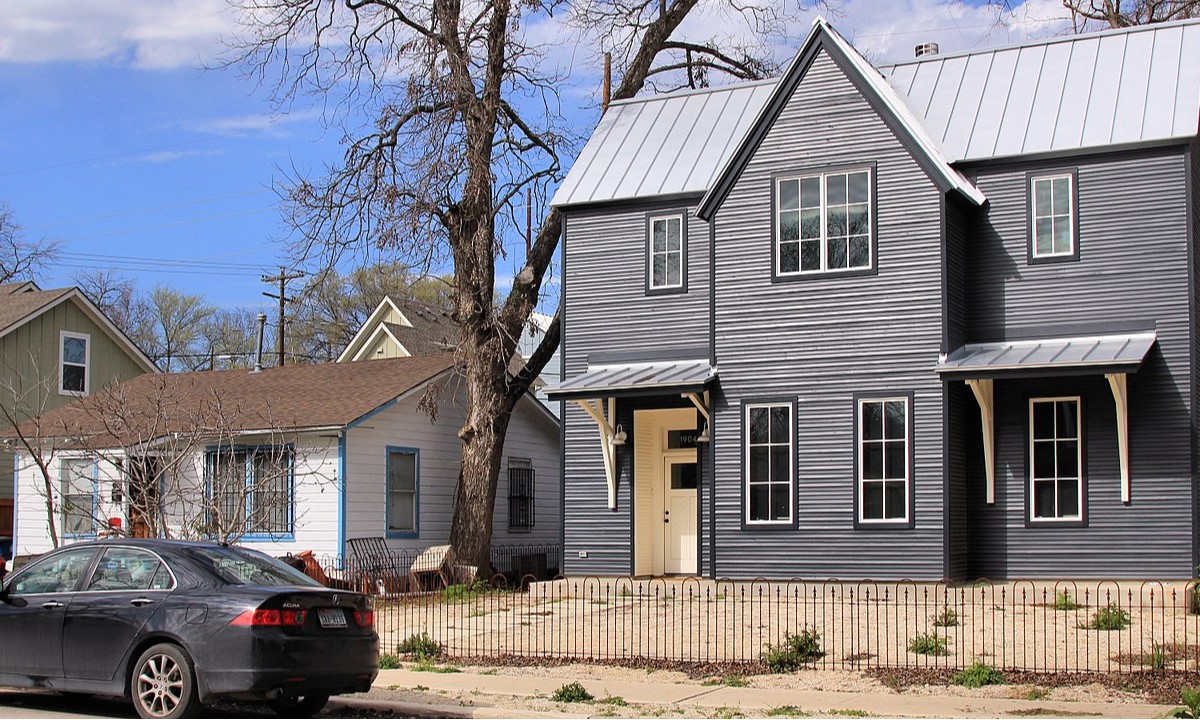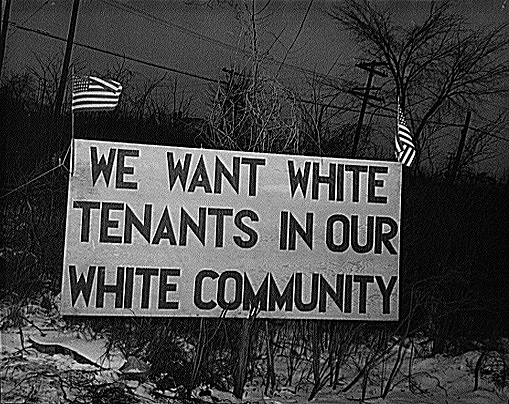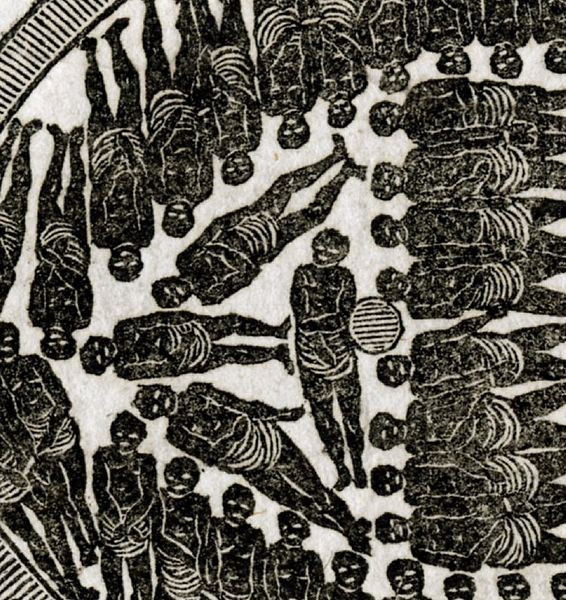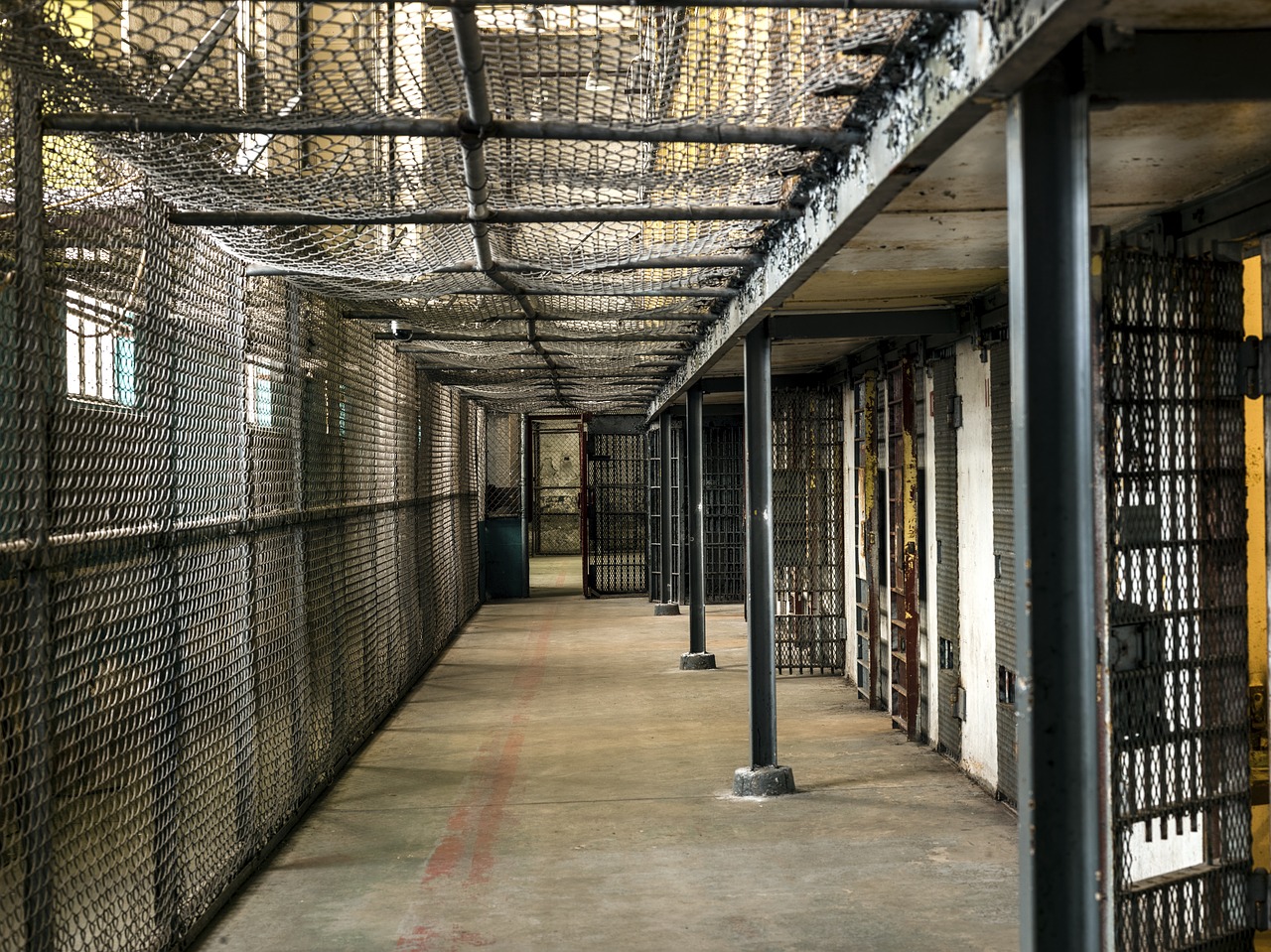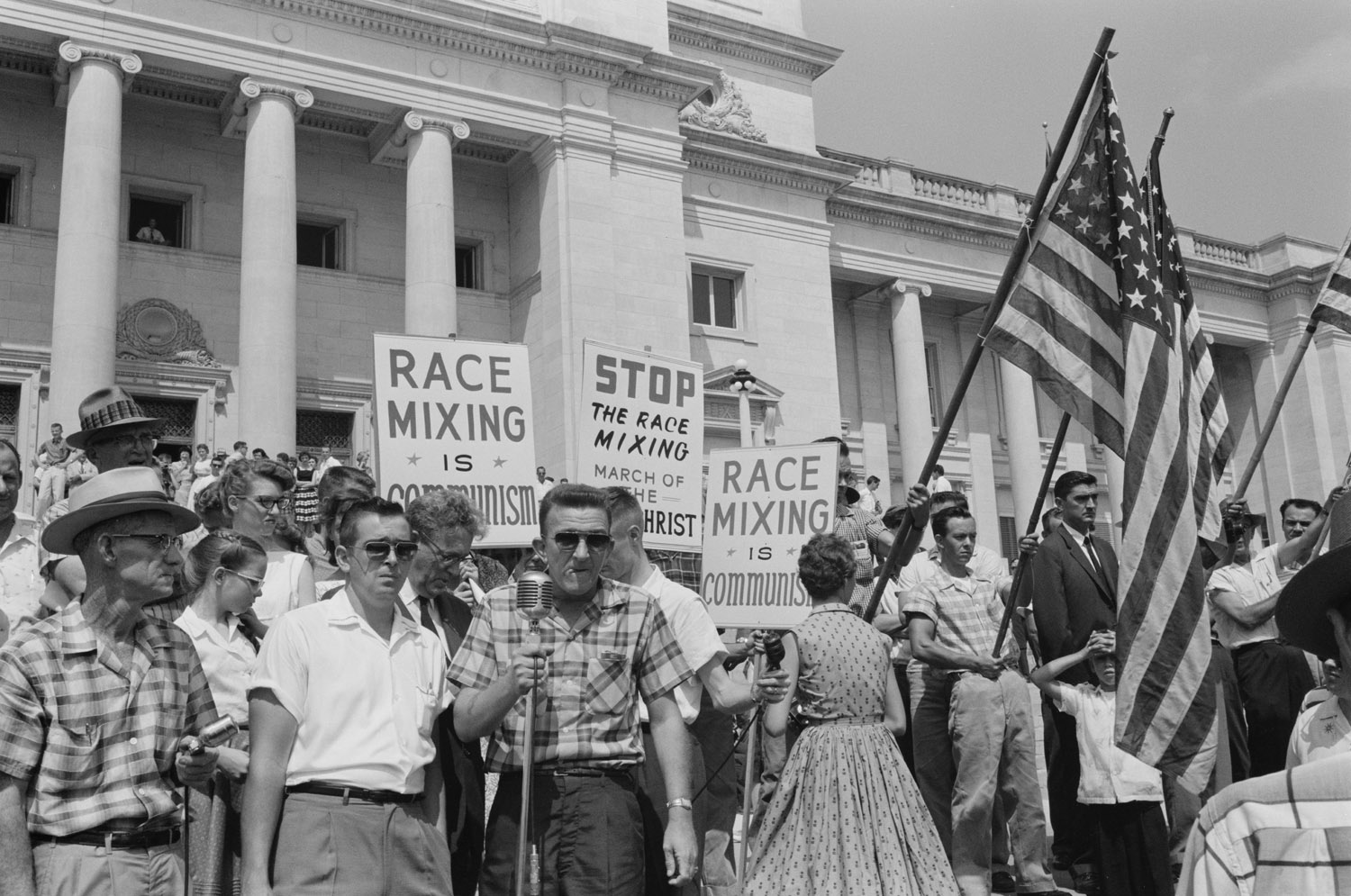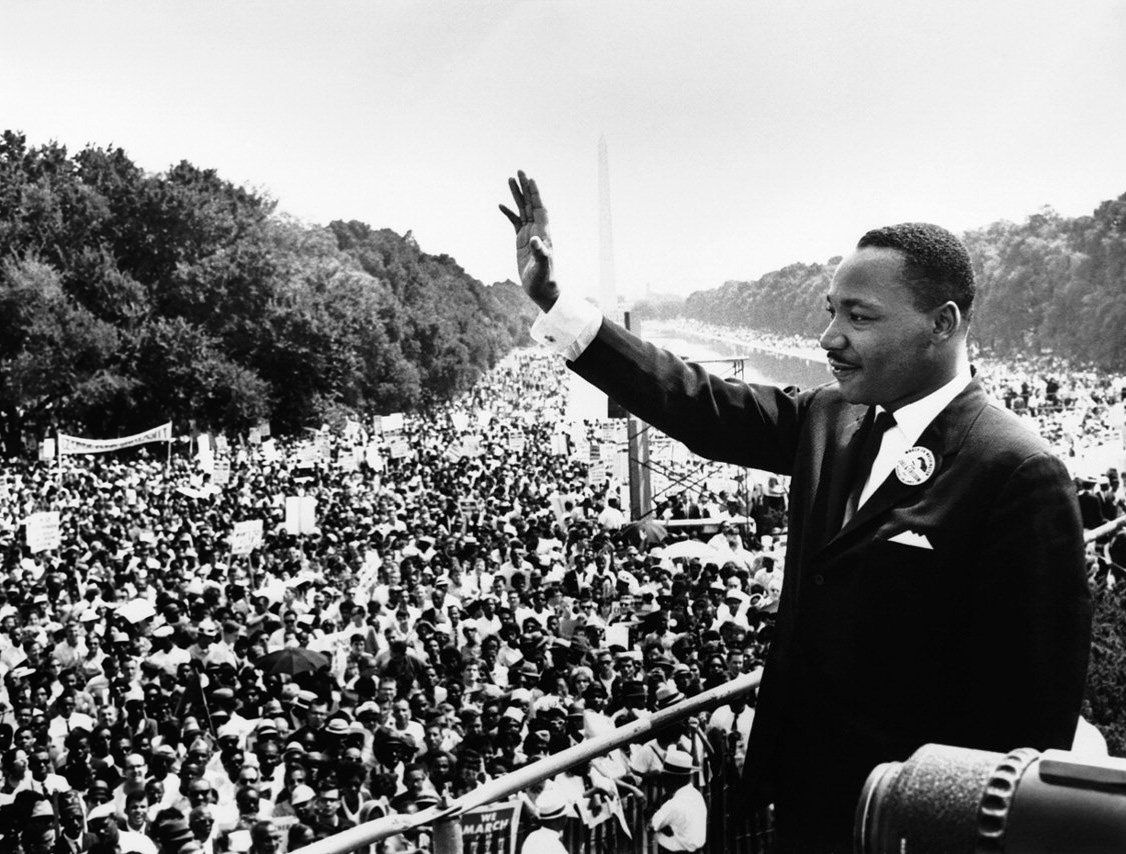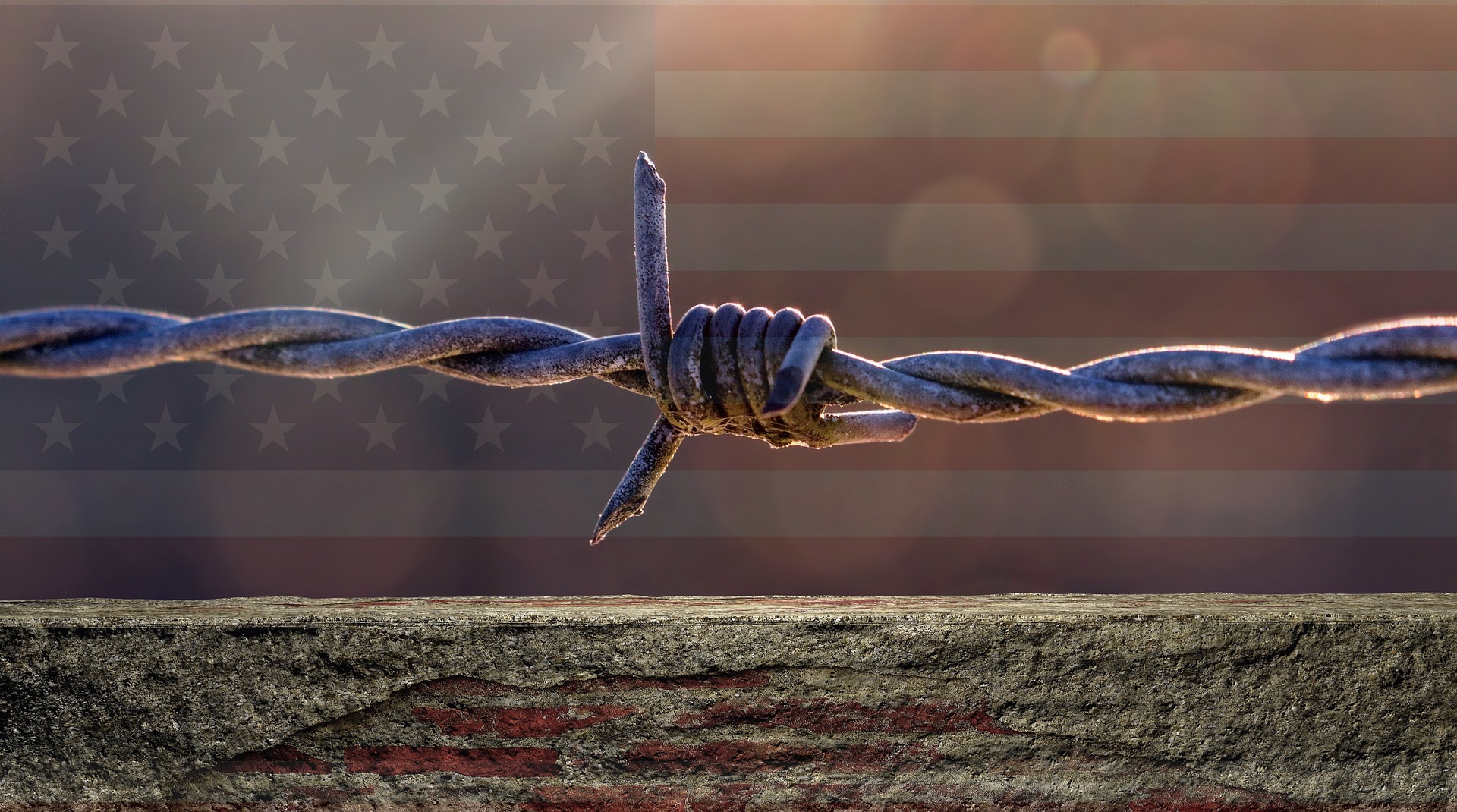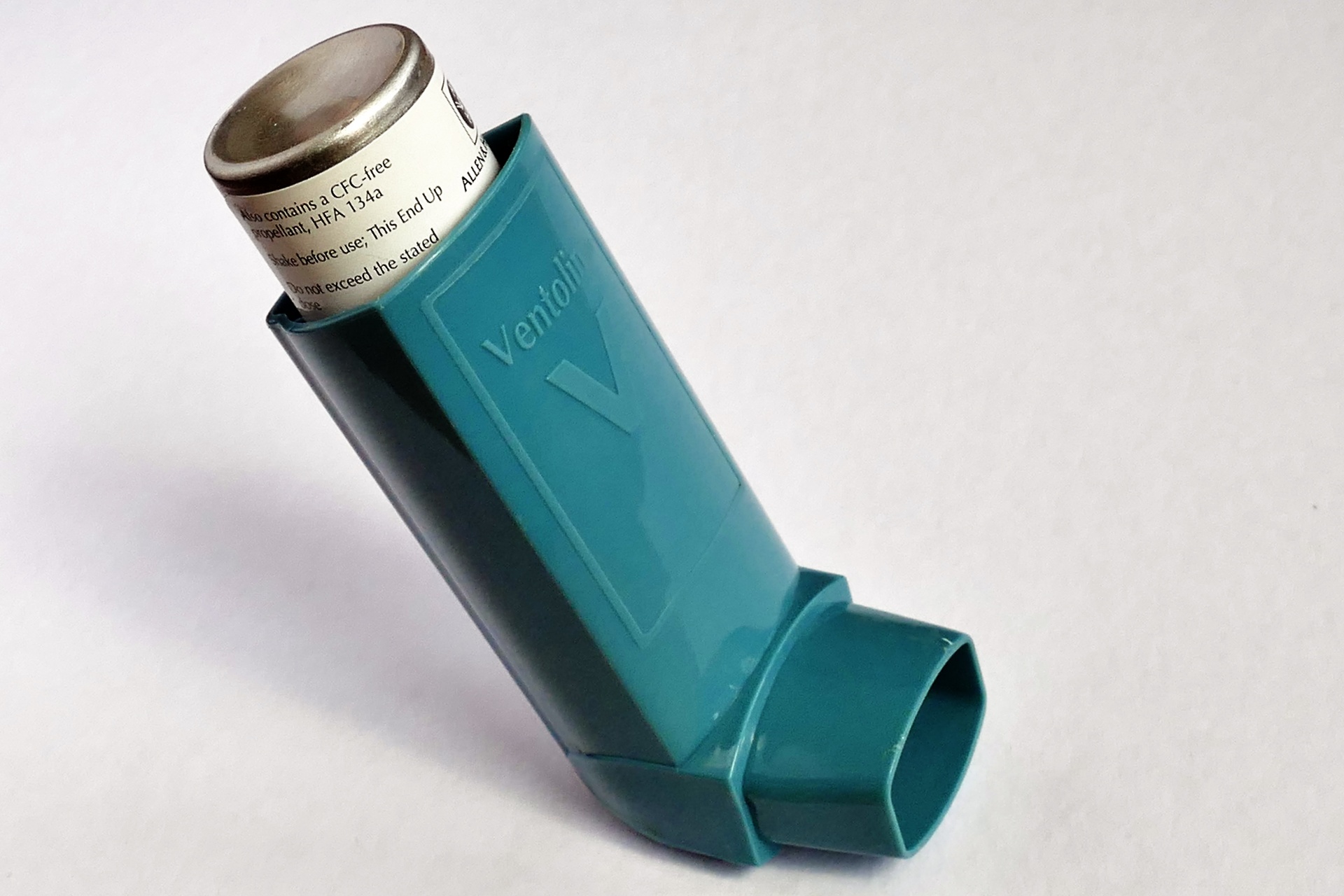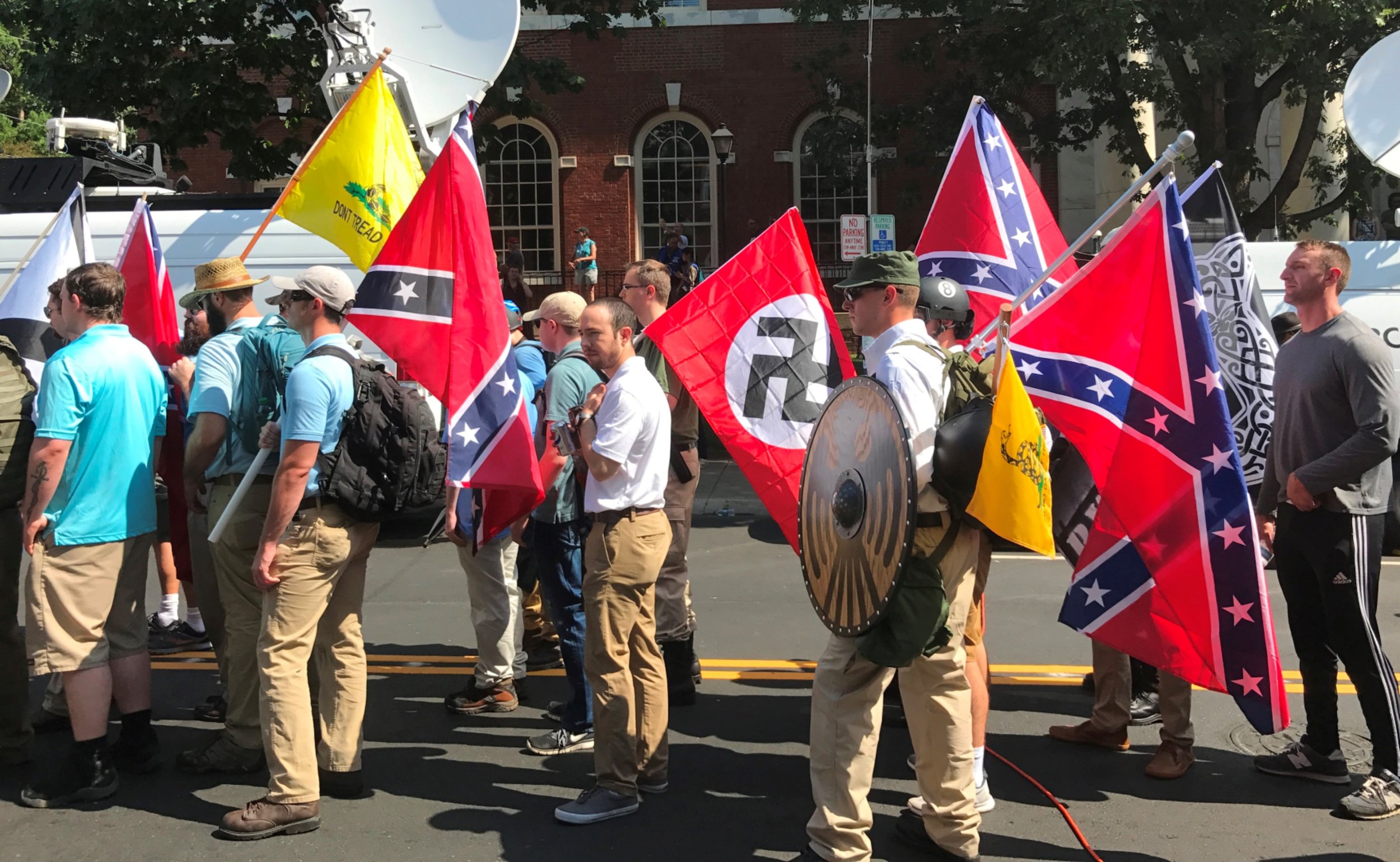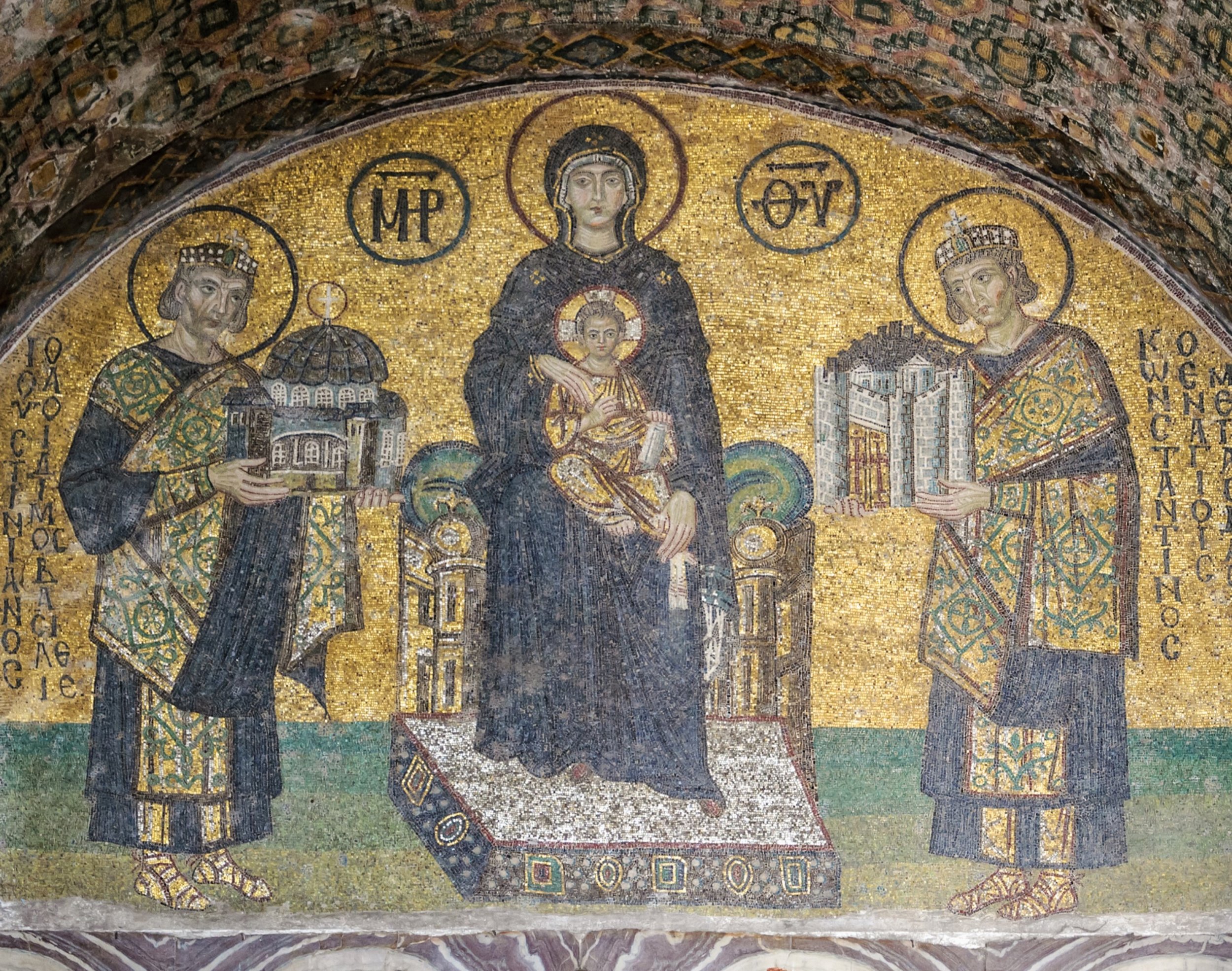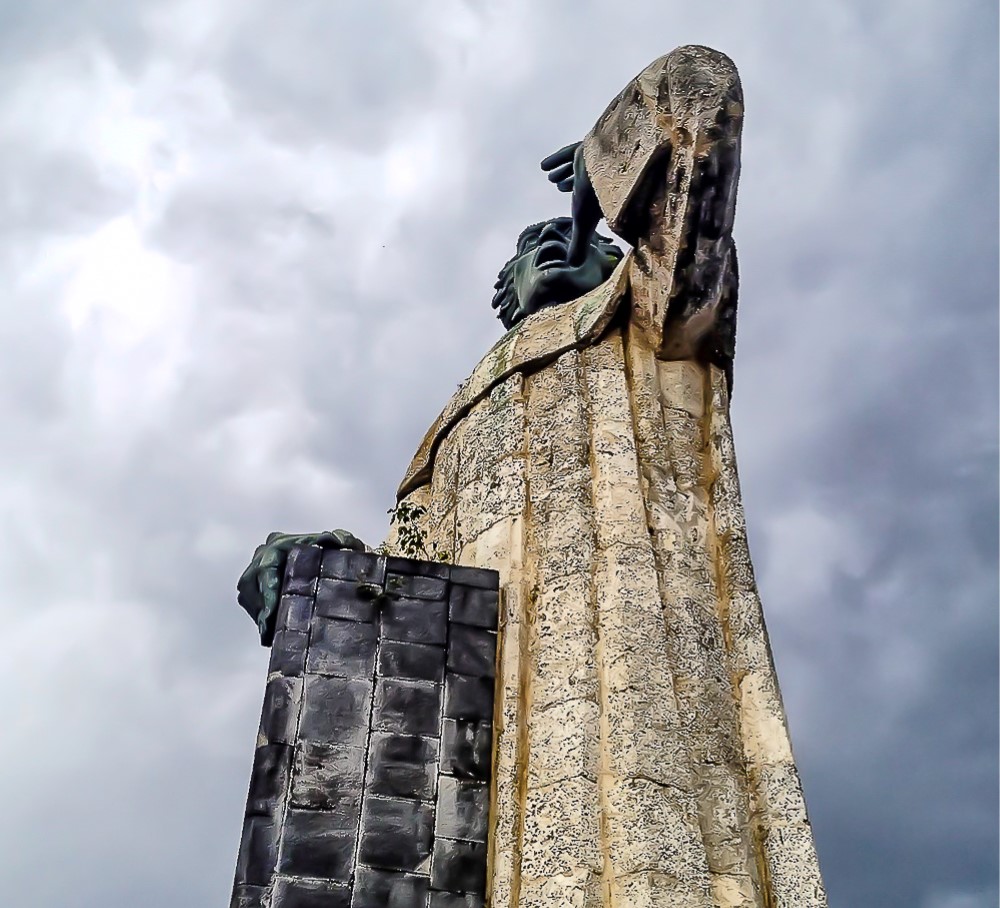White Segregation
Land and Housing Policies
Photograph: The flag of the State of Oregon, founded as a whites-only State, with a whites-only clause in its State Constitution. Oregon passed a Black Exclusion Law passed while a territory in 1844. Oregon was admitted to the Union on February 14, 1859, when Southern politicians agreed that Oregon would be a "free" State in exchange for opening slavery to the southwest States. Oregon continues to be a locus of white supremacist activity. Photo credit: U.S. National Park Service, Wikimedia Commons.
Introduction
Residential segregation through State laws, zoning policies, etc. are important to study because spatial, political, and economic separateness was at the very least a major factor in the construction of racial separateness. U.S. housing policies were designed to promote and preserve wealth for at least certain white Americans. Historian Eric Foner, The Second Founding: How Civil War and Reconstruction Remade the Constitution, W.W. Norton, 2019, p.169 — 170 points out how segregated housing is a feature of slavery, even in American law from Reconstruction:
"In 1968, at the height of the civil rights revolution, the Court came to the verge of revitalizing the Thirteenth Amendment, then stepped back. In Jones v. Alfred H. Mayer Co, a 7-2 majority allowed suits for damages under the Civil Rights Act of 1866 (enacted under that amendment) for racial discrimination in the sale of homes. The majority identified such discrimination, which deprived blacks of the right to own property in the same way as whites, as a stigma that arose from slavery. But the Court has never gone on to define more broadly the "badges and incidents" of bondage [as housing segregation was defined as one of the "badges and incidents" of slavery]. As a result, the Thirteenth Amendment remains essentially a "dead letter" whose purpose was fulfilled when chattel slavery vanished. This is unfortunate because the amendment's language lacks any reference to state action [and could thus apply to citizens and housing developers and real estate agents and city ordinances, for instance]. Its latent power has almost never been invoked as a weapon against the racism that forms so powerful a legacy of American slavery."
See also more general resources on Housing Policy which explores issues that are less racially motivated. This following clip is from our 2019 Conference: Healing Atonement.
Messages and Resources on White Segregation and Housing Policies
Finding a Home in God’s Bigger Story
Intersection Journal, The Telos Collective, April 15, 2021. “Many Christian conservatives decry the decline of “culture”—while seeking “dominion” over media, government, etc.—without doing much to help local communities… More liberal-minded Christians often celebrate a little “diversity training” at work, while practicing NIMBY-ism (“not in my backyard”) in zoning, protecting their kids at all costs, and neglecting low wages and the high cost of living. Are we only interested in a middle- and upper-class diversity, in our unsustainable suburban lifestyles? God cares about our sense of home, place, and community.”
Slides of a presentation given to the 2022 Reconstruction class. The introduction features John Winthrop vs. Roger Williams to highlight the debate over freedom of religious Conscience vs. Christendom. The presentation highlights Christian accomplishments in health and hospitals, education and schools, land ownership and economic justice, and criminal justice reform.
A series of blog posts where we explore many issues as Christian heresy, for which Christians must take responsibility in the frame of repentance. We have designed a study guide to accompany the blog posts. Please consider using it for personal reflection or discussion in your family, church, organization, etc. As relates to housing, please see posts 5, 6, 7, and 14.
White American Evangelical Political Attitudes and Behavior: Explanation and Correctives
White American evangelical political attitudes can be characterized by the debate between John Winthrop and Roger Williams, and their respective attitudes towards Native Americans, slavery, fairness, and faith in civic space. This is a presentation also explores Scripture and church history to argue that Roger Williams was correct. Given to the staff of Emmanuel Gospel Center, Apr 18, 2018, as a follow-up to how Christian restorative justice impacts ministry; audio file here
Other Resources on White Segregation and Housing Policies
Top Articles, Housing Phase 1 (The Unsustainability of White American Suburbs, the Product of Racism):
Vice News, Why American Transit Is So Bad. Vice News, Oct 22, 2020. A 10 minute video showing how U.S. cities are designed to get suburban people into the city, even though transit patterns are otherwise. Once again we see the self-destructive patterns of white supremacy in the formation of white suburbs. Highlights political possibilities for high speed rail, including current projects in TX, FL, and CA. Not Just Bikes, Introduction to Strong Towns & Financially Insolvent American Cities. Not Just Bikes, Nov 2, 2020. A 5 minute video discussing city design from the reviews of the Strong Towns initiative. Focuses on how mixed use buildings (residential and commercial) generates more money for cities than big box outdoor malls. Not Just Bikes, How Suburban Development Makes American Cities Poorer. Not Just Bikes, Nov 16, 2020. Strong Towns video 2: European cities make everything important available to residents on foot. Not Just Bikes, How America Bankrupted its Cities - The Growth Ponzi Scheme. Not Just Bikes, Jan 11, 2021. Strong Towns video 3: a 9 minute video on the cost of making car-dependent suburbs are financially hard to sustain (e.g. road maintenance, etc), making city taxes a requirement for paying for the suburbs. Not Just Bikes, How Bankrupt American Cities Stay Alive - Debt. Not Just Bikes, Apr 5, 2021. Strong Towns video 4: an 11 minute video on how municipal debt funded the growth and maintenance of suburbs, and is not sustainable. Oliver Bahl, Why America Is Terribly Designed. OBF, Nov 3, 2021. A 10 minute video comparing European cities (esp. Amsterdam) and Canadian cities to U.S. cities which are made for cars. In Europe, car parking is underground to save space; bike lanes are protected. Once again we see the self-destructive patterns of white supremacy in the formation of white suburbs. Notes that American high schools need a large parking lot, and wonders if green space or more classroom space would be possible. White suburbs have a precursor in the Homestead Acts and the federal government doling out originally Native land to poor white people. See Keri Leigh Merritt, Masterless Men: Poor Whites and Slavery in the Antebellum South. Cambridge University Press | Amazon page, May 2017. For background, see Nancy Isenberg, White Trash: The 400-Year Untold History of Class in America. Roosevelt House Public Policy Institute of Hunter College, Jun 12, 2017. A 55 minute video. Isenberg observes how terms for poor white people focused on their location and lack of mobility, from “hillbillies” from the hills all the way up to “trailer park” people today. She traces this back to how wealthy British elites talked about poor English people.
Top Articles, Housing Phase 2 (Racial Exclusion in Lending, Appraisals, Steering):
Richard Rothstein, Segregation Myth: Richard Rothstein Debunks an American Lie. Now This News, Jun 26, 2020. An excellent 9 minute video showing how racial segregation was not developed by individual choices in a free market. It was implemented by white supremacist policies at every level of government, using zoning, banking, and other policies. Silkworm, Segregated by Design. Silkworm, 2019. a 17 min video narrated by Rothstein and based on his research. Rachel L. Swarns, Biased Lending Evolves, and Blacks Face Trouble Getting Mortgages. New York Times, Oct 30, 2015. shows that it continues: “In 2014, Hudson approved 1,886 mortgages in the market that includes New Jersey and sections of New York and Connecticut, federal mortgage data show. Only 25 of those loans went to black borrowers. Hudson, while denying wrongdoing, agreed last month to pay nearly $33 million to settle a lawsuit filed by the Consumer Financial Protection Bureau and the Justice Department. Federal officials said it was the largest settlement in the history of both departments for redlining, the practice in which banks choke off lending to minority communities.” Mark Whitehouse, Black Poverty Is Rooted in Real-Estate Exploitation. Bloomberg, Jun 17, 2019. “A new study in Chicago shows how the dream of homeownership was converted into a poverty trap.” Practices such as “contract for deed” were based on predatory financing, where black families were overcharged between $3.2 - 4.0 billion, benefiting mostly white real estate agents and investors. The FHA scandal of the 1970’s led to widespread foreclosures. Laura Sullivan, Tatjana Meschede, Lars Dietrich, & Thomas Shapiro, Amy Traub, Catherine Ruetschlin & Tamara Draut, The Racial Wealth Gap: Why Policy Matters. Institute for Assets and Social Policy at Brandeis University, Demos, 2015. National Association of Home Builders, Huge Wealth Gap Between Home Owners and Renters. NAHB, Sep 3, 2019. “A recent report by the U.S. Census Bureau on household wealth in 2015 reveals that the wealth gap between home owners and renters is striking: The median net worth of home owners is 80 times larger than the median net worth of renters.” Cody Johnston, Katy Stoll, and Will Gordh, Wealth is a White Privilege. Some More News, Jul 18, 2020. A short 10 minute video clip featuring government-sponsored white homeownership. Julian E. Zelizer, Fifty Years Ago, the Government Said Black Lives Matter. Boston Review, May 5, 2016. comments on the Kerner Commission Report of 1968: “Many of the mayors who appeared before the commissioners were fed up with conditions in their cities. “There is a system of apartheid confining the poor and the Negro to the city,” said Mayor Henry Maier of Milwaukee. He called on Congress to pass the fair housing bill, warning that the central cities could not “long endure within a segregated metropolis.”” Bloomberg Quicktake, The $500 Billion Bias Costing People Their Homes. Bloomberg Quicktake, May 14, 2021. appraisals for property taxes. This 15 minute video is titled The Pay Check: The Inequality Tax, and examines where the property tax goes. Assessors don’t see current characteristics of houses; adding value by remodeling or losing value by disrepair is unaccounted for. John Oliver, Housing Discrimination. Last Week Tonight, Jul 26, 2021. is a 32 minute video exploring the racial wealth gap and how housing via government policy contributes to it. Gene Slater, Freedom to Discriminate: How Realtors Conspired to Segregate Housing and Divide America. Heydey | Amazon page, Sep 21, 2021. explains how CA realtors responded to MLK’s definition of freedom as civil rights and economic well-being, by redefining “freedom” in CA Proposition 14 as “freedom from state interference with the housing market.” See Gene Slater, The Inventors of America’s Most Dangerous Idea. The Atlantic, Nov 29, 2021. Izzy Woodruff, Groundbreaking Report Identifies Bias and Systemic Barriers in Real Estate Appraisals. National Fair Housing, Jan 19, 2022. The “Appraisal Standards and Appraiser Criteria report” is the most comprehensive review of bias in the appraisal industry to date, and it presents a roadmap for Congress, regulators, advocates, and the industry to address the nation’s long legacy of bias in the valuation of real estate and build a future in which a family’s most valuable asset is treated fairly.
Top Articles, Housing Phase 3 (Predatory Lending):
In 1968, redlining was declared formally illegal (although it continued), so banks used predatory lending to include higher credit risk black people in loans, with the intention of repossessing their homes. Keeanga-Yamahtta Taylor, Race for Profit: How Banks and the Real Estate Industry Undermined Black Homeownership. The University of North Carolina Press, Oct 2019. Details the early shift in financial strategies, starting in Chicago. Mehrsa Baradaran, How the Other Half Banks: Exclusion, Exploitation, and the Threat to Democracy. Harvard University Press | Amazon page, Mar 2018. Shows how debt-credit is applied unequally to blacks to exploit them and limit their capital asset building. Jamelle Bouie, The Crisis in Black Home Ownership: How the Recession Turned Owners Into Renters and Obliterated Black American Wealth. Slate, Jul 24, 2014. Describes how the financial crisis of 2008-09 brought the predatory lending practices to a climax.
Top Articles, Housing Phase 4 (Racial Vulnerability in Zoning):
Vox, How the US Made Affordable Housing Illegal. Vox, Aug 16, 2021. a short 10 minute video focusing on single family zoning, height restrictions, minimum lot sizes, parking regulations (especially in the San Francisco Bay Area in CA). This means developers build large, single-family homes, which are exclusionary. Includes a helpful chart showing how the more single-family zoning is present, the whiter the neighborhood racially. Vice News, How Property Law Is Used to Appropriate Black Land. Vice News, Aug 11, 2020. shows that “heirs’ property” status allows property shareholders to sell a share of property to someone (or a corporation) who can then sue the other shareholders for the whole property.
Top Articles, Housing Phase 5 (Reparations):
Mark Guarino, Evanston, IL Leads the Country with First Reparations Program for Black Residents. Washington Post, Mar 22, 2021. “The Evanston City Council approved the first phase of reparations to acknowledge the harm caused by discriminatory housing policies, practices and inaction going back more than a century. The 8-to-1 vote will initially make $400,000 available in $25,000 homeownership and improvement grants, as well as in mortgage assistance for Black residents, primarily those can show they are direct descendants of individuals who lived in the city between 1919 and 1969 and suffered from such discrimination.” See comments by Andre M. Perry and Rashawn Ray, Evanston’s Grants to Black Homeowners Aren’t Enough. But They Are Reparations. Washington Post, Apr 1, 2021. “But the Evanston plan is a form of reparations. In fact, we have recommended similar wealth-building strategies, including housing grants, tuition and school loan repayment, small business grants, as well as direct payments, as forms of reparations. In the case of Evanston, the housing grant program is directly linked to the past wrong of housing discrimination for impacted Black people. Homeownership is important because it is the most common way in America to build wealth. For reparations to close the racial wealth gap, some form of housing subsidy must be included. Homes tend to appreciate over time, which provides an engine for intergenerational accumulation. And housing investments yield other investments, such as those in better schools and infrastructure.” Jon Gorey, His Final Wish: Donating His Home to Create a More Diverse Cambridge. Boston.com, Apr 14, 2021. features a touching story highlighting how one person or family can make a difference by donating a house to a non-profit in one’s will. Sarah Mizes-Tan, California Reparations Task Force Discusses Infrastructure’s Discriminatory History. Jefferson Public Radio, Dec 11, 2021.
Top Articles Black Farming:
Pete Daniel, Dispossession: Discrimination Against African-American Farmers in the Age of Civil Rights. Chapel Hill, NC: UNC Press, Mar 29, 2013. and review by Vann R. Newkirk II, The Great Land Robbery. The Atlantic, Sep 2019. “[T]he USDA became the safety net, price-setter, chief investor, and sole regulator for most of the farm economy in places like the Delta… The mega-farms held sway over agricultural policy, resulting in more money, at better interest rates, for the plantations themselves. At every level of agrigovernment, the leaders were white.” See 15 minute video by The Atlantic, How Black Americans Were Robbed of Their Land. The Atlantic, Sep 12, 2019. Sylvia A. Harvey, For Decades, the USDA Was Black Farmers’ Worst Enemy — Here’s How It Became an Ally. Truthout, Aug 6, 2016. Augiustus Corbett, Overdue Justice for Black Farmers! The Historic Settlement For Black Farmers After Decades Fighting. Defiant Lawyers, Aug 11, 2014.
Top Articles Sunset Towns or Sundown Towns:
James Loewen, Sundown Towns: A Hidden Dimension of American Racism. Indie Bound, Jul 31, 2018. about the hundreds of towns that were/are whites-only. See also his online database. Logan Jaffe, The Legend of A-N-N-A: Revisiting an American Town Where Black People Weren’t Welcome After Dark. ProPublica, Nov 7, 2019. Brent Renaud, Black Lives Matter in a Haven for White Supremacists. Boston Globe, Jun 19, 2020. re: Harrison, Arkansas. Connie Sartini, Was Groton Ever A Sundown Town? Groton Herald, Sep 10, 2020. gives important data on New England in general and Groton, MA in particular. See also Deanna Pan, Once a Ku Klux Klan Stronghold, Groton Fights its Reputation as a ‘Sundown Town’. History News Network, originally Boston Globe, Oct 7, 2020. Lila Seidman, Glendale Confronts Its Racist Past, Apologizing for ‘Sundown’ Laws. Los Angeles Times, Oct 15, 2020. Glendale, CA in Los Angeles; brief history of 100 sundown towns in CA
Top Articles International Comparison on Housing Policy:
The Economist, How an Obsession with Home Ownership Can Ruin the Economy. The Economist, Jan 22, 2020. very important comparison with Switzerland, which prioritizes renting, not owning. Ownership favors segregation, restrictive zoning, restrictive supply, a population less willing to move to find work, thus unemployment. Critiques mortgage interest deduction on taxes as a distortion of the housing market. Eamonn Fingleton, In World's Best-Run Economy, House Prices Keep Falling -- Because That's What House Prices Are Supposed To Do. Forbes, Feb 2, 2014. Germany a helpful counterexample to the US, and shows the priority on renting rather than owning. Dorothy Brown, How Home Ownership Keeps Blacks Poorer Than Whites. Forbes, Dec 10, 2012.
All Resources
Heller School for Social Policy and Management (Brandeis University) various papers; see Housing and Community Stability
Enterprise Community, Undesign the Redline (Enterprise Community website) timeline of segregation and housing policy in the U.S. Exhibits in Atlanta, Chicago, Cleveland, Denver, Los Angeles
PBS, Where Race Lives: Your Home Is Your Future (PBS | WGBH website) Interactive website: explore how government policies and past discrimination have made generating wealth easier for some Americans than others.
Parable of the Polygons: A Playable Post on the Shape of Society (website) how harmless choices can make a harmful world; a simulation exercise on how personal preferences can lead to social segregation
Signe-Mary McKernan, Caroline Ratcliffe, C. Eugene Steuerle, Caleb Quakenbush, Emma Kalish, Serena Lei, Fiona Blackshaw, Nine Charts about Wealth Inequality in America (Urban Institute website) data from 1963 - 2017 about wealth, home ownership, inequality, etc. by race
Center for Budget and Policy Priorities: Housing (website)
Mapping Inequality, Redlining in New Deal America (website) maps of New Deal America, made by the Home Owners' Loan Corporation, the origin of red lining; see Henry Grabar, Here’s How the Federal Government Made the Maps That Crippled Black Neighborhoods. Slate, Oct 21, 2016.
Wikipedia, Equal Credit Opportunity Act (Wikipedia) the 1974 law that allowed banks to take two incomes into account for home mortgage calculations
Wikipedia, Homestead Acts (Wikipedia)
Wikipedia, Federal Housing Administration (Wikipedia) where 98% of loans when to white families in the first 30 years; $120b head start
Wikipedia, G.I. Bill (Wikipedia)
Wikipedia, Seneca Falls (Wikipedia) and Daisy Alioto, The Lost Village in New York City. NPR, May 6, 2014. about the obliteration of a black neighborhood in NYC
Wikipedia, Rondo and Summit University in St. Paul, MN (Wikipedia) about the obliteration of the black neighborhood called Rondo in the 1960's by Interstate development
Thomas W. Mitchell, Restoring Hope for Heirs Property Owners: The Uniform Partition of Heirs Property Act. American Bar. and Sarah Breitenbach, Heirs' Property Challenges Families, States. Pew Charitable Trusts, Jul 15, 2015. and Heirs' Property Retention Coalition, Preserving Your Property: A Guide to Heirs' Property in North Carolina. Southern Coalition for Social Justice, Jul 2009.
William Toll and Marshall F. Stevenson, Boston's African-Americans and American Jews: Two Views. chapter from The Death of an American Jewish Community, 1992.
Douglas S. Massey, American Apartheid: Segregation and the Making of the Underclass. Harvard University Press | Amazon page, 1993.
Christopher Silver, The Racial Origins of Zoning in American Cities (pdf file, 1997) from the early 1900's
Arnold R. Hirsch, Making the Second Ghetto: Race and Housing in Chicago 1940 - 1960. University of Chicago Press | Amazon page, 1998.
Janine DeFao, Oakland Tenants Get Big Settlement / Decrepit Apartments to Be Fixed Up. San Francisco Gate, Oct 17, 2000. and Judith Scherr, Tenants Win Big Fraud Case Against Landlord. East Bay Express, Mar 2, 2011.
Carol Estes, Second Chance for Black Farmers. Yes Magazine, Jun 30, 2001. and Sylvia A. Harvey, For Decades, the USDA Was Black Farmers’ Worst Enemy — Here’s How It Became an Ally. Truthout, Aug 6, 2016.
David Rusk, The “Segregation Tax”: The Cost of Racial Segregation to Black Homeowners. Brookings Institute, Oct 1, 2001.
Richard Perez-Pena, Study Finds Asthma In 25% of Children In Central Harlem. New York Times, Apr 19, 2003. and Stephen W. Nicholas, Addressing the Childhood Asthma Crisis in Harlem: The Harlem Children’s Zone Asthma Initiative. American Journal of Public Health, Feb 2005.
Nanette Asimov, Brown vs. Board of Education: 50 Years Later. San Francisco Gate, May 16, 2004.
Jason Corburn, Jeffrey Osleeb, and Michael Porter, Urban Asthma and the Neighbourhood Environment in New York City. Elsevier Health and Place, Nov 5, 2004.
Ira Katznelson, When Affirmative Action Was White. W.W. Norton & Company | Amazon page, 2005.
Manny Fernandez, A Study Links Trucks’ Exhaust to Bronx Schoolchildren’s Asthma. New York Times, Oct 29, 2006.
Mike Katz-Lacabe, City of San Leandro and Housing Discrimination. San Leandro Bytes, Jul 5, 2007.
Kevin M. Kruse, White Flight: Atlanta and the Making of Modern Conservatism. Princeton University Press | Amazon page, Jul 29, 2007.
Beryl Satter, Family Properties: Race, Real Estate, and the Exploitation of Black Urban America. Metropolitan Books | Amazon page, 2009.
Gary Orfield, St Louis, School Desegregation and Housing Policy. HTH Video, Jun 11, 2009.
Beryl Satter, Family Properties: How the Struggle Over Race and Real Estate Transformed Chicago and Urban America. Picador | Amazon page, 2010.
Jeff Wiltse, Contested Waters: A Social History of Swimming Pools in America. The University of North Carolina Press | Amazon page, May 1, 2010. efforts to desegregate community swimming pools and neighborhoods resulted in white people building private club and backyard swimming pools
Anthony Bradley, The Suburbanization of Social Justice. World, May 5, 2010. although I would advocate doing something about housing policy and mortgage laws
Sean F. Reardon, Kendra Bischoff, Growth in the Residential Segregation of Families by Income, 1970 - 2009. Stanford University, Nov 2011.
Andrew Kahrl, The Land Was Ours: African American Beaches from Jim Crow to the Sunbelt South. Harvard University Press | Amazon page, Mar 2012. and review by Brentin Mock, How Black Land Became White Sand: The Racial Erosion of the U.S. Coasts (Grist, May 30, 2014.
Cameron McWhirter, Red Summer: The Summer of 1919 and the Awakening of Black America. St. Martin’s Griffin | Amazon page, Jul 2012.
Dorothy Brown, How Home Ownership Keeps Blacks Poorer Than Whites. Forbes, Dec 10, 2012.
Tanner Colby, Some of My Best Friends Are Black: The Strange Story of Integration in America. Penguin Books | Amazon page, 2013.
Mary Szto, Real Estate Agents as Agents of Social Change: Redlining, Reverse Redlining, and Greenlining. Seattle Journal for Social Justice, 2013.
Ta-Nehisi Coates, The Ghetto is Public Policy. The Atlantic, Mar 19, 2013.
Pete Daniel, Dispossession: Discrimination Against African-American Farmers in the Age of Civil Rights. The University of North Carolina Press | Amazon page, Mar 29, 2013. and review by Vann R. Newkirk II, The Great Land Robbery. The Atlantic, Sep 2019. “President Franklin D. Roosevelt’s New Deal life raft for agriculture helped start the trend in 1937 with the establishment of the Farm Security Administration, an agency within the Department of Agriculture. Although the FSA ostensibly existed to help the country’s small farmers, as happened with much of the rest of the New Deal, white administrators often ignored or targeted poor black people—denying them loans and giving sharecropping work to white people… [T]he USDA became the safety net, price-setter, chief investor, and sole regulator for most of the farm economy in places like the Delta. The department could offer better loan terms to risky farmers than banks and other lenders, and mostly outcompeted private credit. In his book Dispossession, Daniel calls the setup “agrigovernment.” Land-grant universities pumped out both farm operators and the USDA agents who connected those operators to federal money. Large plantations ballooned into even larger industrial crop factories as small farms collapsed. The mega-farms held sway over agricultural policy, resulting in more money, at better interest rates, for the plantations themselves. At every level of agrigovernment, the leaders were white.” See 15 minute video by The Atlantic, How Black Americans Were Robbed of Their Land. The Atlantic, Sep 12, 2019.
Rebecca Baird-Remba and Gus Lubin, 21 Maps of Highly Segregated Cities in America. Business Insider, Apr 25, 2013.
Tiffany M. Gardner, Alec Irwin, and Curtis W. Peterson, No Shelter From the Storm: Reclaiming the Right to Housing and Protecting the Health of Vulnerable Communities in Post-Katrina New Orleans. Health and Human Rights Journal, Aug 29, 2013.
Robert J. Sampson, Division Street, USA. New York Times, Oct 26, 2013. how residence affects attainment, incarceration
Phoebe Flanigan, Where Do We Grow From Here? Urban Farms and Gentrification in East Austin. KUT Austin's NPR, Nov 21, 2013.
Nancy Updike, Rental Gymnastics. NPR, This American Life radio, Nov 22, 2013. about housing discrimination in NYC
Nikole Hannah-Jones, The Missionary. NPR, This American Life radio, Nov 22, 2013. about George Romney's attempt to reverse housing discrimination as Secretary of HUD
A Moore, 8 Successful and Aspiring Black Communities Destroyed by White Neighbors. Atlanta Blackstar, Dec 4, 2013.
Mychal Denzel Smith, The Effects of Ignoring Systemic Racism. The Nation blog, Jan 27, 2014.
Eamonn Fingleton, In World's Best-Run Economy, House Prices Keep Falling -- Because That's What House Prices Are Supposed To Do. Forbes, Feb 2, 2014. Germany a helpful counterexample
Julianne Hing, Gentrification Report: Black and Latino Displacement is Remaking the Bay Area. Color Lines, Apr 7, 2014.
Daniel Jose Older, Gentrification’s Insidious Violence: The Truth About American Cities. Salon, Apr 8, 2014.
Thomas Sugrue, The Origins of the Urban Crisis: Race and Inequality in Postwar Detroit. Princeton University Press | Amazon page, Apr 27, 2014.
Ta-Nehisi Coates, The Case for Reparations. The Atlantic, May 21, 2014. , 20th century California, racism against blacks
Alexis Madrigal, The Racist Housing Policy That Made Your Neighborhood. The Atlantic, May 22, 2014.
Blair L.M. Kelley, ‘The Case for Reparations’ Reignited an Important and Long-Standing Debate. The Root, May 24, 2014.
Whet Moser, How Housing Discrimination Created the Idea of Whiteness. Chicago Magazine, May 28, 2014. subtitled "Segregationist policies divided Chicago—and America. Those ideas impacted blacks as well as “probationary whites,” setting the stage for stories like “The Case for Reparations” today."
eHistory, The Invasion of America: How the U.S. Took Over an Eighth of the World. video, Jun 2, 2014.
Brandon McMorrow, Making the Fairmount Line Gentrification-Proof. Boston Globe, Jul 15, 2014.
Jamelle Bouie, The Crisis in Black Home Ownership: How the Recession Turned Owners Into Renters and Obliterated Black American Wealth. Slate, Jul 24, 2014.
Kevin Hartnett, Gentrification: White People Following White People. Boston Globe, Aug 6, 2014.
California Newsreel, Race: The Power of an Illusion. Vimeo, Aug 13, 2014. a documentary series
N.D.B. Connolly, A World More Concrete: Real Estate and the Remaking of Jim Crow South Florida. University of Chicago Press | Amazon page, Aug 25, 2014.
John Light, Ferguson, the Foreclosure Crisis and America’s Hedge-Fund Landlords. Bill Moyers, Sep 5, 2014.
Nathalie Baptiste, Them That's Got Shall Get. American Prospect, Oct 12, 2014. subtitled, "Two years after we last investigated the the foreclosure crisis in the most affluent black county in America, things aren't exactly looking up—except, maybe, for the banks."
Richard Rothstein, The Making of Ferguson: Public Policies at the Root of its Troubles. Economic Policy Institute, Oct 15, 2014.
Emily Badger, Why Government Policy - Not Personal Prejudice - Is to Blame for Ferguson. Washington Post, Oct 15, 2014.
Charles Marohn, The Conservative Case Against the Suburbs. The American Conservative, Oct 15, 2014.
Ta-Nehisi Coates, The Racist Housing Policies That Built Ferguson. The Atlantic, Oct 17, 2014.
Jane Slaughter, Manufactured Emergency: The Neoliberal Assault on Michigan. Truth Out, Oct 18, 2014.
Derek Thompson, Why Middle-Class Americans Can't Afford to Live in Liberal Cities. The Atlantic, Oct 29, 2014.
Braden Goyette, How Racism Created America's Chinatowns. Huffington Post, Nov 11, 2014.
Emily Badger, Nicholas Kristof on What Whites Just Don't Get About Racial Inequality. Washington Post, Nov 20, 2014.
David F. Krugler, 1919, The Year of Racial Violence: How African Americans Fought Back. | Amazon page, Dec 2014.
Phenderson Djeli Clark, A History of White “Race Riots” in America. Media Diversified, Dec 1, 2014.
Jason Sokol, The North Isn’t Better Than the South: The Real History of Modern Racism and Segregation Above the Mason-Dixon Line. Salon, Dec 14, 2014.
Laura Sullivan, Tatjana Meschede, Lars Dietrich, & Thomas Shapiro, Amy Traub, Catherine Ruetschlin & Tamara Draut, The Racial Wealth Gap: Why Policy Matters. Institute for Assets and Social Policy at Brandeis University, Demos, 2015.
Tim Wise, Challenging Racism, Privilege, and Denial. youtube, Jan 13, 2015. 20:08 min mark, on government sponsored housing discrimination
Alana Semuels, Is Ending Segregation the Key to Ending Poverty? The Atlantic, Feb 3, 2015. Chicago's initiative placing African-American families in wealthier white areas
Nick Chiles, Segregation in America Is Driven By Rich White People, Who Are Increasingly Choosing to Separate Themselves From Everyone Else. Atlanta Black Star, Feb 25, 2015.
Kenya Downs, Why is Milwaukee So Bad for Black People? NPR, Mar 5, 2015.
Laura Shin, The Racial Wealth Gap: Why A Typical White Household Has 16 Times The Wealth Of A Black One. Forbes, Mar 26, 2015. homeownership #1; education #2; labor markets #3
Alana Semuels, Where the White People Live. The Atlantic, Apr 10, 2015.
Alisa, Baltimore: The Value of Property Over Human Life. blog, Apr 27, 2015.
Lee Celano, Poor Teens in Baltimore Face Worse Conditions Than Those in Nigeria. RT, Apr 28, 2015.
Emily Badger, The Long Painful and Repetitive History of How Baltimore Became Baltimore. Washington Post, Apr 29, 2015.
Jamelle Bouie, The Deep, Troubling Roots of Baltimore's Decline. Slate, Apr 29, 2015.
Richard Rothstein, From Ferguson to Baltimore: The Fruits of Government-Sponsored Segregation. Economic Policy Institute, Apr 29, 2015.
Jacob S. Rugh, Len Albright, and Douglas S. Massey, Race, Space, and Cumulative Disadvantage: A Case Study of the Subprime Lending Collapse. Soc. Problems, May 1, 2015. “describe how residential segregation and individual racial disparities generate racialized patterns of subprime lending and lead to financial loss among black borrowers in segregated cities. We conceptualize race as a cumulative disadvantage because of its direct and indirect effects on socioeconomic status at the individual and neighborhood levels, with consequences that reverberate across a borrower's life and between generations. Using Baltimore, Maryland as a case study setting, we combine data from reports filed under the Home Mortgage Disclosure Act with additional loan-level data from mortgage-backed securities. We find that race and neighborhood racial segregation are critical factors explaining black disadvantage across successive stages in the process of lending and foreclosure, controlling for differences in borrower credit scores, income, occupancy status, and loan-to-value ratios. We analyze the cumulative cost of predatory lending to black borrowers in terms of reduced disposable income and lost wealth. We find the cost to be substantial. Black borrowers paid an estimated additional 5 to 11 percent in monthly payments and those that completed foreclosure in the sample lost an excess of $2 million in home equity. These costs were magnified in mostly black neighborhoods and in turn heavily concentrated in communities of color. By elucidating the mechanisms that link black segregation to discrimination we demonstrate how processes of cumulative disadvantage continue to undermine black socioeconomic status in the United States today.”
Justin Wolfers, Why the New Research on Mobility Matters: An Economist's View. New York Times, May 4, 2015. and conservative David Brooks, A Sensible Version of Donald Trump. New York Times, Oct 27, 2015. acknowledging that this matters, although he doesn't explore residential segregation
Jeanette Woods, Philadelphia Marks 30th Anniversary of MOVE Bombing. NPR, May 13, 2015.
NPR, Historian Says Don't 'Sanitize' How Our Government Created Ghettos. NPR May 14, 2015.
New York Times Editorial Board, Housing Apartheid, American Style. New York Times, May 16, 2015.
Alexis Stephens, Life in Boston as a Liberal Gentrifier. Next City, May 26, 2015.
New York Times Editorial Board, Racial Penalties in Baltimore Mortgages. New York Times, May 30, 2015.
Douglas S. Massey, The Legacy of the 1968 Fair Housing Act. Sociology Forum, Jun 2015. examines history of residential segregation, legislative process of the Fair Housing Act, trends in residential segregation since 1970, and prospects. See also Natasha M. Trifun, Residential Segregation after the Fair Housing Act. American Bar Association, 2011.
Alana Semuels, Where Should Poor People Live? The Atlantic, Jun 2, 2015. rich people don't want poor people in their neighborhoods
Yoni Applebaum, McKinney, Texas, and the Racial History of Swimming Pools. The Atlantic, Jun 8, 2015.
Richard Rothstein, America’s Big Race Lie: How Big Banks and Racist Policies Helped Shape Segregation, Police Brutality. Salon, Jun 17, 2015.
Alana Semuels, Has America Given Up on the Dream of Racial Integration? The Atlantic, Jun 19, 2015. about TX turning down federal $ so as to not change white neighborhoods
Alana Semuels, How Housing Policy Is Failing America's Poor. The Atlantic, Jun 24, 2015. on Section 8
Alana Semuels, Supreme Court vs. Neighborhood Segregation. The Atlantic, Jun 25, 2015. SCOTUS on Inclusive Communities, interpreting FHA'68 expansively; housing is like busing; see rebuttals by Howard Husock, Unfair "Fair Housing". City Journal, Spr 2016. who argues housing is a ladder commodity, argues against interpreting FHA expansively; and Kriston Capps, Texas Refuses to Follow Fair Housing Rules. CityLab, Feb 3, 2016. showing how States find legal loopholes
Alana Semuels, Can Better Data Help Solve America's Housing Problems? The Atlantic, Jul 8, 2015. Obama's mapping tool and goals for cities, against FHA'68
Melissa Harry-Perry, Imagining a U.S. With Fair Housing. MSNBC, Jul 11, 2015.
Alana Semuels, The Destruction of a Black Suburb. The Atlantic, Jul 13, 2015. about Lincoln Heights, OH
Gabriel Metcalf, What's the Matter With San Francisco? Its Famed Progressive Politics. Atlantic CityLab, Jul 23, 2015. Rebutted by Mark. blog, Jul 23, 2015. And also Robert Cruickshank, Progressives Didn't Cause the San Francisco Housing Crisis. Calitix, Jul 23, 2015.
Robert Shiller, The Housing Market Still Isn't Rational. New York Times, Jul 24, 2015.
Ansel Herz, Accusing the HALA Committee of “Playing the Race Card” Is an Attempt to Derail an Important Conversation. Slog, Jul 28, 2015.
NPR, The Problem We All Live With. NPR This American Life, Jul 31, 2015. about desegregation
Emily Badger, Black Poverty Is Different From White Poverty. Washington Post, Aug 12, 2015.
Michelle Denise Jackson, Advocacy into Action: An Interview with NYC Housing Authority Chair Shola Olatoye. For Harriet, Aug 18, 2015.
Lisa Sorg, Self-Help, Durham Housing Authority and the City: Big Questions About Affordable Housing. Bull City Rising, Aug 19, 2015.
Alice Ollstein, Bankers Are Buying Baltimore's Debt, Charging Families Crazy Interest Rates, Then Taking Their Homes. Think Progress, Aug 25, 2015.
Leah Penniman, Radical Farmers Use Fresh Food to Fight Racial Injustice and the New Jim Crow. Yes Magazine, Sep 5, 2015.
Rachel L. Swarns, Biased Lending Evolves, and Blacks Face Trouble Getting Mortgages. New York Times, Oct 30, 2015. shows that it continues: “In 2014, Hudson approved 1,886 mortgages in the market that includes New Jersey and sections of New York and Connecticut, federal mortgage data show. Only 25 of those loans went to black borrowers. Hudson, while denying wrongdoing, agreed last month to pay nearly $33 million to settle a lawsuit filed by the Consumer Financial Protection Bureau and the Justice Department. Federal officials said it was the largest settlement in the history of both departments for redlining, the practice in which banks choke off lending to minority communities.” Quoted by Wikipedia, Institutional Racism (Wikipedia)
Meserette Kentake, The Ocoee Massacre. Kentake Page, Nov 2, 2015.
Priscilla Frank, Gordon Parks' Photo Essay On 1950's Segregation Needs to Be Seen Today. Huffington Post, Nov 3, 2015.
Karen Weise, How Gentrification Really Changes Cities. Bloomberg, Nov 9, 2015.
Alana Semuels, How to Decimate a City. The Atlantic, Nov 20, 2015. about Syracuse, NY
Eula Biss, White Debt. New York Times, Dec 6, 2015. more a reflection on racial guilt and indebtedness, but some anecdotes about land and housing
Kelly McEvers, Utah Reduced Chronic Homelessness By 91 Percent - Here's How. NPR, Dec 10, 2015.
Matthew Desmond, Evicted: Poverty and Profit in the American City. Crown | Amazon page, 2016. See also Matthew Desmond, Forced Out. The New Yorker, Feb 8 & 15, 2016. and Matthew Desmond, The Eviction Economy. New York Times, Mar 5, 2016. poverty is not just a product of joblessness and low wages, but exploitation; and Diane Rehm, Matthew Desmond: Evicted. Diane Rehm Show, Mar 7, 2016.
Jake Blumgart, How Bernie Sanders Helped Make an Expensive City in Vermont Permanently Affordable. Slate, Jan 19, 2016. not about race per se, but land trusts are a constructive and proven strategy; see also Boston's Dudley Street Neighborhood Initiative (Wikipedia) and Community Wealth, DSNI (Community Wealth website)
Cindy Casares, Texas Finally Acknowledges Rangers Killed Hundreds of Latinos. Latina, Feb 3, 2016.
Emily Badger, The Poor Are Better Off When We Build More Housing for the Rich. Washington Post, Feb 15, 2016.
Jonathan Coppage, Affordable Housing Starts from the Bottom Up. The American Conservative, Feb 24, 2016. cites municipal zoning laws as a political device
Emily Badger, Why Losing a Home Means Losing Everything. Washington Post, Feb 29, 2016.
David Scharfenberg, Boston's Struggle With Income Segregation. Boston Globe, Mar 6, 2016.
Emily Deruy and Janie Boschma, Where Children Rarely Escape Poverty. The Atlantic, Mar 7, 2016.
Preston Lauterbach, Memphis Burning. Places Journal, Mar 2016. Part 1 of The Inequality Chronicles
Zach Cartwright, Bernie Sanders Replaces Stump Speech with Epic Call for Native American Justice in Arizona. U.S. Uncut, Mar 18, 2016.
Alana Semuels, The Role of Highways in American Poverty. The Atlantic, Mar 18, 2016.
Joseph Stromberg, Highways Gutted American Cities. So Why Did They Build Them? Vox, Mar 18, 2016.
Camila Domonoske, Denying Housing Over Criminal Record May Be Discrimination, Feds Say. NPR, Apr 4, 2016.
Gustavo Arellano, Anaheim's Racist-as-Hell History Beyond the KKK, and Why OC Weekly Covers It. OC Weekly, Mar 2, 2016.
Thomas B. Edsall, How the Other Fifth Lives. New York Times, Apr 27, 2016.
Alana Semuels, How Segregation Has Persisted in Little Rock. The Atlantic, Apr 27, 2016.
Ted Mellnik, Darla Cameron, Denise Lu, Emily Badger and Kat Downs, American's Great Housing Divide: Are You a Winner or a Loser? Washington Post, Apr 28, 2016.
Leah Penniman, After a Century In Decline, Black Farmers Are Back And On the Rise. Yes Magazine, May 5, 2016.
Julian E. Zelizer, Fifty Years Ago, the Government Said Black Lives Matter. Boston Review, May 5, 2016. comments on the Kerner Commission Report of 1968: “Many of the mayors who appeared before the commissioners were fed up with conditions in their cities. “There is a system of apartheid confining the poor and the Negro to the city,” said Mayor Henry Maier of Milwaukee. He called on Congress to pass the fair housing bill, warning that the central cities could not “long endure within a segregated metropolis.”” Zelizer narrates the political history behind the Kerner Report, white vs. black responses to the subject matter, and the creation of the fair housing bill.
Emily Badger, Why a Housing Scheme Founded in Racism Is Making a Resurgence Today. Washington Post, May 13, 2016.
Lucy Tiven, How Discrimination Shapes Your City. Attn, May 29, 2016. re: pollution, Chinatowns, hostile architecture, public transportation, and highways
Ardelia Lee, The Detroit Wall: A Tale of How Federal Policy Helped Divide A City. Daily Detroit, Jun 6, 2016. how a developer built a six foot wall separating black and white communities in order to get an FHA loan approved to develop the white community's houses
Alvin Chang, Living in a Poor Neighborhood Changes Everything About You. Vox, Jun 6, 2016. very helpful narrative and graphical presentation
Nikole Hannah-Jones, Choosing a School for My Daughter in a Segregated City. New York Times Magazine, Jun 9, 2016.
Sue Dremann, East Palo Alto Runs Out of Water, Development on Hold. Palo Alto Online, Jun 19, 2016.
Nancy Isenberg, White Trash: The 400-Year Untold History of Class in America. Viking | Amazon page, Jun 21, 2016.
Emily Badger, Why Highways Have Become the Center of Civil Rights Protests. Washington Post, Jul 13, 2016.
Taylor Gee, Something is Rotten in the State of Minnesota: Behind the Shooting Death of Philando Castile Lies the Worst Racial Gap in the Country. Politico, Jul 16, 2016.
Alia Wong, Where Books Are All But Nonexistent. The Atlantic, Jul 14, 2016. in high-poverty urban neighborhoods
Daniel Hertz, Where Do the Parties Stand on Housing? The American Conservative, Jul 28, 2016.
Thomas C. Frohlich, Evan Comen and Michael B. Sauter, Black and White Inequality in All 50 States. 24/7 Wall St, Aug 3, 2016.
Kriston Capps, Tim Kaine's Vision for the Future of Fair Housing. CityLab, Aug 12, 2016.
Alice Kemp-Habib, How Bad Urban Planning Led To The Birth Of A Billion-Dollar Genre. The Fader, Aug 18, 2016.
John Elgion and Robert Gebeloff, Affluent and Black, and Still Trapped by Segregation. New York Times, Aug 20, 2016.
ABC7 News, El Dorado Hills Community Under Fire for "Whites Only" Policy. ABC7 News, Aug 25, 2016.
David A. Graham, Shattering Charlotte's Myth of Racial Harmony. The Atlantic, Sep 22, 2016. discusses residential segregation, changes in public school policy
Isabel Wilkerson, The Long-Lasting Legacy of the Great Migration. The Atlantic, Sep 22, 2016. an inspiring, mostly anecdotal spotlight; features some of the challenges that black Americans faced trying to leave the South (tickets denied, etc.) and arriving in the North and West (housing, jobs, education, policing, etc.). See also Brentin Mock, The Great Migration: The First Moving-to-Opportunity Project. CityLab, Jan 25, 2018. studies the economic standing of blacks in the South compared to the North
Alan Pyke, To Understand Charlotte's Rage, You Have to Understand Its Roads. Think Progress, Sep 23, 2016. good reminder of the geography of race, and also the Fusion movement of the late 1800's and how that coalition of blacks and lower-income whites was overturned
Editorial Board, Mr. Trump’s Government Bailout. New York Times, Oct 3, 2016. about massive tax exemptions through the real estate developer loophole
Max Ehrenfreund, The Remarkable Thing That Happens to Poor Kids When You Help Their Parents With Rent. Washington Post, Oct 12, 2016.
Max Galka, What Does New York Do With All Its Trash? One City's Waste – in Numbers. The Guardian, Oct 27, 2016.
New York Times Editorial Board, Ben Carson’s Warped View of Housing. New York Times, Dec 19, 2016.
Ann Owens, How the Rich Wanting the Best for Their Kids is Segregating Our Neighborhood. London School of Economics, Dec 22, 2016.
Joe Hirsch, Bronxites to City: Slash Our Trash. Mott Haven Herald, Jan 2, 2017.
Alvin Chang, White America is Quietly Self-Segregating. Vox, Jan 18, 2017.
Dunja Djudjic, Dramatic Drone Photos Show a Difference Between the Rich and the Poor. DIY Photography, Feb 1, 2017.
Peter Coy, The Big Reason Whites Are Richer Than Blacks in America. Bloomberg, Feb 8, 2017.
Madeline Bills, It’s Almost Impossible for Single Ladies to Buy Homes in Boston. Boston Magazine, Feb 10, 2017.
Alana Semuels, ‘Segregation Had to Be Invented’. The Atlantic, Feb 17, 2017.
Janelle Jones, The Racial Wealth Gap: How African-Americans Have Been Shortchanged Out of the Material to Build Wealth. Economic Policy Institute, Feb 13, 2017.
Heather Gilligan, An Entire Manhattan Village Owned by Black People Was Destroyed to Build Central Park. Timeline, Feb 22, 2017.
James Q. Whitman, When the Nazis Wrote the Nuremberg Laws, They Looked to Racist American Statutes. Los Angeles Times, Feb 22, 2017.
Nick Chiles, Everyone Pays A Hefty Price For Segregation, Study Says. NPR Code Switch, Mar 17, 2017. References Metropolitan Planning Council, The Cost of Segregation: Lost Income. Lost Lives. Lost Potential.. Metropolitan Planning Council, Mar 2017.
Janine Jackson, Housing, Community and Land Are Human Rights. Truthout, Mar 24, 2017.
Metropolitan Planning Council, The Cost of Segregation. Metro Planning, Mar 28, 2017.
Whet Moser, Chicago Isn’t Just Segregated, It Basically Invented Modern Segregation. Chicago Magazine, Mar 31, 2017.
Richard Florida, How Our Cities Are Increasing Inequality, Deepening Segregation, and Failing the Middle Class — and What We Can Do About It. Basic Books | Amazon page, Apr 11, 2017. and review by Nicole Gelinas, Why America’s Great Cities Are Becoming More Economically Segregated. New York Times, Jun 26, 2017.
Chris Wilson, These Are the Most Economically Segregated Cities in America. Time, Apr 18, 2017.
Richard Rothstein, The Color of Law: A Forgotten History of How Our Government Segregated America. Liveright | Amazon page, May 2, 2017. outstanding historical material. See review by Carl Paulus, The Roots of Segregation. The American Conservative, May 5, 2017. See also Terry Gross, A 'Forgotten History' Of How The U.S. Government Segregated America. NPR, May 3, 2017.
Matthew Desmond, How Homeownership Became the Engine of American Inequality. New York Times, May 9, 2017.
The Young Turks, Here's the Real Reason You Can't Afford a House. The Young Turks, May 21, 2017.
Ashley Finigan, A Case for Reparations at the University of Chicago. Black Perspectives, May 22, 2017.
Douglas Rice, Trump Budget Would Increase Homelessness and Hardship in Every State, End Federal Role in Community Development. Center for Budget and Policy Priorities, May 23, 2017. HUD budget cut by 15%
AJ+, Inside Chicago Part 1: The Racist History of Chicago's Housing Policies. AJ+, May 25, 2017. an 8 minute video featuring redlining, restrictive covenants, federal subsidies to whites, private realtors who played on racial fears, violent response to a black realtor, public housing that concentrated poverty. More than half of Chicago's black population lives in 20 of its 77 neighborhoods.
AJ+, Inside Chicago Part 2: The Racist History of Chicago's Housing Policies. AJ+, May 25, 2017. an 8 minute video on Chicago Public Schools, the country's fourth largest school district, failing its students (9% are white; most are black and Latino). It has 20% of Illinois students, but receives only 15% of its education funding. Further cuts mean cutting social workers and support staff, busing for integration, and resources.
AJ+, Inside Chicago Part 3: Chicago's South Side Isn't Waiting To Be Saved. AJ+, May 27, 2017. an 8 minute video about activists and initiatives in the South Side.
David Bryant, Ginger Haggerty, Cynthia Parker, Mimi Turchinetz, and Esther Schlorholtz, Reducing Racial Wealth Inequalities in Greater Boston: Building a Shared Agenda. Federal Reserve Bank of Boston, May 31, 2017.
Jon Gorey, What Real Estate Agents, Sellers Have to Tell Buyers - And What They Don't. Boston Magazine, Jun 1, 2017. Re: lack of transparency
DeNeen L. Brown, When Portland Banned Blacks: Oregon’s Shameful History as an ‘All-White’ State. Washington Post, Jun 7, 2017.
Nancy Isenberg, White Trash: The 400-Year Untold History of Class in America. Roosevelt House Public Policy Institute of Hunter College, Jun 12, 2017. Isenberg observes how terms for poor white people focused on their location and lack of mobility, all the way up to “trailer park” people today. She traces this back to how wealthy British elites talked about poor English people.
Audrey McGlinchy, Residents Of East Austin, Once A Bustling Black Enclave, Make A Suburban Exodus. NPR, Jul 12, 2017.
Tanvi Misra, How Asian Americans Remade Suburbia. Atlantic CityLab, Jun 14, 2017.
Bernadette Atuahene, Don’t Let Detroit’s Revival Rest on an Injustice. New York Times, Jul 22, 2017.
Debra Bruno, How Chicago Learned Privatizing Public Housing Wasn't Enough. Politico, Jul 20, 2017.
Michelle D. Layser, How Affordable Housing Can Chip Away at Residential Segregation. Salon, Aug 9, 2017.
Richard Scheinn, Real Estate: Developer Describes ‘Epic’ Impact of Google’s Downtown San Jose Plans. San Jose Mercury News, Aug 14, 2017.
Emily Badger, How Redlining’s Racist Effects Lasted for Decades. New York Times, Aug 24, 2017.
Richard Rothstein, Why Los Angeles is Still a Segregated City After All These Years. Los Angeles Times, Aug 20, 2017. white protests of black communities, government-sponsored segregation from the New Deal onward
Chuck Collins, Loan Sharks Were Meant to Be Eradicated. Now They're Back. The Guardian, Aug 23, 2017. not "mom and pop" landlords, but Wall Street private equity firms practicing private predatory mortgage lending where you don't build equity and don't own until your last payment
Paul Roberts, This Is What Really Happens When Amazon Comes to Your Town. Politico, Oct 19, 2017.
Justin Fox, Must-Reads of 2017: Getting Serious About Land. Bloomberg, Dec 27, 2017. see also Noah Smith, Faster Growth Begins with a Land Tax in U.S. Cities. Bloomberg, Oct 24, 2017. and Peter R. Orszag, To Fight Inequality, Tax Land. Bloomberg View, Mar 3, 2015.
Katharine Schwab, The Airbnb For Affordable Housing Is Here. Co.Design, Nov 21, 2017.
Ryan D. Enos, How Segregation Leads to Racist Voting by Whites. Vox, Nov 28, 2017.
Connor Sheets, UN Poverty Official Touring Alabama's Black Belt: "I Haven't Seen This" in the First World. Alabama.com, Dec 8, 2017.
Akilah Johnson and the Boston Globe Spotlight Team, Boston. Racism. Image. Reality. Boston Globe, Dec 10, 2017.
Andrew Ryan and the Boston Globe Spotlight Team, A Brand New Boston, Even Whiter Than the Old. Boston Globe, Dec 11, 2017. re: the Seaport District of Boston
Politifact, Donald Trump Wrong That Black Homeownership Rate Is at a Record High. Politifact, Dec 11, 2017. Gets rated False, and National Association of Real Estate Brokers, African American Homeownership Falls to 50-year Low. NAREB, date unknown.
Noah Smith, Land is Underrated as a Source of Wealth. Bloomberg, Jan 2, 2018.
Henry Grabar, California Bill Would Allow Unrestricted Housing by Transit, Solve State Housing Crisis. Slate, Jan 5, 2018.
Rachel M. Cohen, The Fight for the Suburbs. New Republic, Jan 17, 2018.
Aaron Glantz and Emmanuel Martinez, Kept Out: How Banks Block People of Color from Homeownership. Associated Press, Feb 15, 2018.
Janae Ladet, Veronica Gaitán, and Maya Brennan, Black Homeownership and the American Dream: An Expert Dialogue. How Housing Matters, Feb 15, 2018. incredible fact-based discussion broken out by black ethnicities, generations and time periods, various economic and social consequences, cities, and policy impacts; helpful links
Tom Keane, Let's Face It. There Will Never Be Room for the Middle Class in Boston. Boston Globe, Feb 20, 2018.
Glenn Thrush, Ben Carson’s HUD, Planning Cuts, Spends $31,000 on Dining Set for His Office. New York Times, Feb 27, 2018.
Mehrsa Baradaran, How the Other Half Banks: Exclusion, Exploitation, and the Threat to Democracy. Harvard University Press | Amazon page, Mar 2018. shows how debt-credit is applied unequally to blacks to exploit them and limit their capital asset building.
Leonard E. Colvin, Company Wants to Put Trash Dump Site in Black Norfolk Neighborhood. New Journal and Guide Local News in Virginia, Mar 22, 2018.
Scott Simon, 'To Us, It's Very Much Racial': Bombings Highlight Austin's '2 Cities'. NPR, Mar 24, 2018.
Alana Semuels, Chicago's Awful Divide. The Atlantic, Mar 28, 2018.
Rachel M. Cohen, Donald Trump and the GOP Are Expanding a Controversial Obama-Era Public Housing Program. The Intercept, Apr 2, 2018.
Sharon Lerner, EPA Violated the Law By Failing to Investigate Civil Rights Complains, Court Rules. The Intercept, Apr 3, 2018.
Alvin Chang, Living in a Poor Neighborhood Changes Everything About Your Life. Vox, Apr 4, 2018.
German Lopez, Christina Animashaun, and Javier Zarracina, How America Has — and Hasn’t — Changed Since Martin Luther King Jr.’s Death, in 11 Charts. Vox, Apr 4, 2018. From economic well-being to criminal justice issues, racial inequality is still very real in America.
Dianna Wray, Austin Is Stepping Up Its Fight Against Gentrification. Huffington Post, Apr 11, 2018.
Gene Demby, 50 Years Ago: President Johnson Signed The Fair Housing Act. NPR, Apr 11, 2018.
Terry Gross, First-Ever Evictions Database Shows: 'We're In the Middle Of A Housing Crisis'. NPR, Apr 12, 2018.
Editorial Board, Blacks Still Face a Red Line on Housing. New York Times, Apr 14, 2018.
Tracy Jan, HUD Secretary Ben Carson To Be Sued for Suspending Obama-Era Fair-Housing Rule. New York Times, May 7, 2018.
Max Blau, ‘It Does Something to Your Soul When Everyone Losing Their Homes Looks Like You’. Politico, May 24, 2018. re: evictions in Durham, NC
Anthony Alofsin, A Defense of the Suburbs. The Atlantic, Jun 6, 2018.
The Atlantic, White Racism Ignites Dynamite in Black Ghettos. The Atlantic, Jun 26, 2018. re: evictions in Durham, NC
Carolette R. Norwood, Mapping the Intersections of Violence on Black Women’s Sexual Health within the Jim Crow Geographies of Cincinnati Neighborhoods. Frontiers, Jun 30, 2018.
PBS News Hour, The Story of American Poverty, As Told By One Alabama County. (PBS News Hour, Jul 7, 2018. More than 18 million Americans live in “extreme poverty,” according to a report from the United Nations, which ranked poverty in the U.S. alongside some of the poorest areas in the world. The UN Special Rapporteur for Extreme Poverty paid a visit to the U.S. last year, drawing worldwide attention to his findings. This Alabama African American community lacks clean sewage water treatment because the State of Alabama has opposed extending public infrastructure there. This is a case study of how most Americans have benefited from massive public investment yet insist that American society is an “meritocracy of individual achievement,” and why “small government conservatism” is often a smokescreen for “prejudice and systemic racial injustice.”
Michelle Conlin, Spiders, Sewage, and a Flurry of Fees — The Other Side of Renting a House from Wall Street. Reuters, Jul 27, 2018.
Henry Grabar, Ben Carson Ends Obama-Era Efforts to Reduce Housing Segregation. Slate, Aug 13, 2018.
Bradley L. Hardy, Trevon D. Logan, and John Parman, The Historical Role of Race and Policy for Regional Inequality. The Hamilton Project, September 2018. notes how white flight to the suburbs drained city centers of jobs, tax revenues for schools, etc.
Noah Smith, Ben Carson and HUD Get Ready to Take On the Nimbys. Bloomberg, Sep 12, 2018. proposal to roll back "not in my backyard" zoning rules to allow more housing development
Veronica Gaitán, How Housing Can Determine Educational, Health, and Economic Outcomes. How Housing Matters, Sep 19, 2018.
Isaac William Martin and Kevin Beck, How How Does Gentrification Affect Homeowners and Renters Differently? How Housing Matters, Sep 26, 2018.
Emily Badger and Quoctrung Bui, Detailed New National Maps Show How Neighborhoods Shape Children for Life. New York Times, Oct 1, 2018. subtitled, "Some places lift children out of poverty. Others trap them there. Now cities are trying to do something about the difference." Very useful interactive map.
Mehrsa Baradaran and Darrick Hamilton, Elizabeth Warren’s New Housing Proposal Is Actually a Brilliant Plan to Close the Racial Wealth Gap. Slate, Oct 26, 2018.
Jacquinn Sinclair, 'The Gentrification Game' Puts Boston's Stark Changes In Sharp Relief. WBUR, Oct 30, 2018.
Alana Semuels, Amazon’s HQ2 Will Only Worsen America’s "Great Divergence". The Atlantic, Nov 13, 2018.
Andre M. Perry, Jonathan Rothwell, and David Harshbarger, The Devaluation of Assets in Black Neighborhoods. Brookings Institute, Nov 27, 2018. and Andre Perry, Homeowners Have Lost $156 Billion by Living in a “Black Neighborhood”. CNN, Dec 7, 2018. find that even controlling for housing quality, levels of schools and crime, houses in black neighborhoods are worth $48,000 less than houses in white neighborhoods
Jordan Heller, One Of America’s Poorest Cities Has A Radical Plan To Remake Itself. Huffington Post, Nov 27, 2018. features employee-owned corporations, green jobs, in Cleveland OH
Louisville, Kentucky WLKY, Black Lives Matter Flips Houses for Low-Income Families. WLKY, Nov 29, 2018.
Sarah Mervosh, Minneapolis, Tackling Housing Crisis and Inequity, Votes to End Single-Family Zoning. New York Times, Dec 13, 2018.
John Iadarola, How to Solve the Housing Crisis. The Damage Report, Dec 19, 2018. interview with Randy Shaw, author of How Generation Priced Out: Who Gets to Live in the New Urban America. University of California Press | Amazon page, Nov 2018.
Tracy Jan, Ben Carson’s HUD Dials Back Investigations into Housing Discrimination. Washington Post, Dec 24, 2018. "Carson has only once used his authority as HUD secretary to scrutinize widespread housing discrimination, moving ahead under public pressure on an investigation against Facebook that was initiated during the Obama administration. Obama’s HUD secretaries used the tool...an average of 10 times per year, while George W. Bush’s second HUD secretary used it an average of five times per year."
Karen Weise, Microsoft Pledges $500 Million for Affordable Housing in Seattle Area. New York Times, Jan 16, 2019. a corporate bank for affordable housing; an encouraging development
Lew Finfer, The 'Good Intentions' Program That Devastated Boston's Neighborhoods. Boston Globe, Jan 18, 2019.
Lisa Cunningham, Damon Young’s What Doesn’t Kill You Makes You Blacker. Pittsburgh City Paper, Feb 27, 2019. about gentrification in Pittsburgh, PA. Ryan Deto, Damon Young and the Trauma of Being Black in Pittsburgh. Pittsburgh City Paper, Feb 27, 2019. Notes that wages in Pittsburgh (2010 - 2015) increased 8.1% for whites and decreased 19.6% for blacks.
Laura Paddison, How Finland Solved Homelessness. Huffington Post, Jan 30, 2019. And Dawn Foster, What Can the UK Learn from How Finland Solved Homelessness. The Guardian, Mar 22, 2017.
Jessica Rinaldi, African Americans’ Economic Setbacks from the Great Recession Are Ongoing – and Could Be Repeated. The Conversation, Feb 5, 2019
TPT, Jim Crow of the North. TPT Originals, Feb 25, 2019. A 1 hr documentary focusing on Minnesota. Covers racial covenanting, the federal adoption of racial covenanting, etc.
Hasan Minhaj, Civil Rights. Patriot Act, Mar 3, 2019. on Trump's Cabinet members dropping civil rights cases: Departments of Justice, Housing and Urban Development, Education, Health and Human Services, Commerce (which oversees the U.S. Census)
Anne Branigin, Amid Some Gains, Black Homeownership Continues to Fall: Report. The Root, Mar 4, 2019.
David Brooks, The Case for Reparations. New York Times, Mar 7, 2019.
ATTOM Staff, Seriously Underwater U.S. Properties Increase From A Year Ago. ATTOM Data Solutions, May 7, 2019.
Governor Lael Brainard, Is the Middle Class within Reach for Middle-Income Families? Federal Reserve, May 10, 2019. points out, “The average wealth of black households in which the head had a bachelor's degree ($271,200) was 26 percent less than that of white households in which the head did not attend college ($367,800).”
Alan Pyke, New HUD Budget Proposes Massive Cuts to Affordable Housing Programs. Think Progress, Mar 12, 2019. “In a proposal that's anything but populist, the administration would strip vital funding for vulnerable residents of both urban and rural communities.”
Michael Hobbes, Why America Can’t Solve Homelessness. Huffington Post, May 19, 2019.
Lawrence O’Donnell, Rep. Katie Porter: Ben Carson Gave ‘Zero Competent Answers’ In Hearing. The Last Word | MSNBC, May 21, 2019. an example of Trump’s strategy of disempowering agencies by installing secretaries who undermine the agencies; however, Alexandria Ocasio-Cortez managed to get him to agree to policy changes to not arbitrarily disqualify people from public housing; see John Iadarola, Alexandria Ocasio-Cortez Brilliantly Traps Ben Carson. The Damage Report, May 22, 2019.
Jacqueline Rabe Thomas, Separated by Design: How Some of America’s Richest Towns Fight Affordable Housing. ProPublica, May 22, 2019. “Invisible walls created by local zoning boards and the state government block affordable housing and, by extension, the people who need it”
Farhad Manjoo, America’s Cities Are Unlivable. Blame Wealthy Liberals. New York Times, May 22, 2019. re: California politics, single occupancy zoning laws, and resistance to change
David Brooks, The Welfare State Is Broken. Here’s How to Fix It. New York Times, May 27, 2019. “A social entrepreneur in Britain shows the way.” The most telling issue was housing: “Ella and the team worked together to stabilize her most immediate issue — negotiating away eviction notices.” This demonstrates that the Housing First approach - a different housing policy where we view housing as part of a human rights fabric - is required to “fix” the welfare system without throwing people into homelessness. But do Brooks and other conservatives have the heart, mind, and stomach to undo the racial and class prejudice built into the U.S. housing market?
Mark Whitehouse, Black Poverty Is Rooted in Real-Estate Exploitation. Bloomberg, Jun 17, 2019. “A new study in Chicago shows how the dream of homeownership was converted into a poverty trap.” Practices such as “contract for deed” were based on predatory financing, where black families were overcharged between $3.2 - 4.0 billion, benefiting mostly white real estate agents and investors. The FHA scandal of the 1970’s led to widespread foreclosures.
Richard Walker, The New Deal Didn’t Create Segregation. Jacobin Magazine, Jun 18, 2019. critiques Richard Rothstein’s account of history as too narrow; “Housing segregation, like racism in general, has deep roots in American society. It wasn’t imposed by the federal government — and certainly not by the New Deal.”
Tessa Stuart, Ta-Nehisi Coates Dismantles Mitch McConnell’s Remarks on Reparations. Rolling Stone, Jun 19, 2019.
Chris Linski, Rental Price Burden In Mass. Surpasses New York And D.C., Report Finds. WBUR, Jun 19, 2019. focuses on wages, but should also include indebtedness
Leif Relgstad, What Happened When Austin Asked Homeless People How To Solve Homelessness. Huffington Post, Jun 27, 2019.
Michael Hobbes, Progressive Boomers Are Making It Impossible For Cities To Fix The Housing Crisis. Huffington Post, Jul 6, 2019. “Residents of wealthy neighborhoods are taking extreme measures to block much-needed housing and transportation projects”
Laurel Wamsley, Oregon Legislature Votes To Essentially Ban Single-Family Zoning. NPR, Jul 1, 2019. and Michael Andersen, Maps: Portland’s 1924 Rezone Legacy is ‘A Century of Exclusion’. Sightline Institute, May 25, 2018. for background
Erick Trickey, How Minneapolis Freed Itself From the Stranglehold of Single-Family Homes. Politico, Jul 11, 2019. “Desperate to build more housing, the city just rewrote its decades-old zoning rules.”
Dylan Matthews, America Has a Housing Segregation Problem. Seattle May Just Have the Solution. Vox, Aug 4, 2019. providing information about schools, assistance to fill out applications, and information about additional financial assistance
Kevin M. Kruse, What Does a Traffic Jam in Atlanta Have to Do With Segregation? Quite a Lot. New York Times Magazine, Aug 14, 2019. “This intertwined history of infrastructure and racial inequality extended into the 1950s and 1960s with the creation of the Interstate highway system. The federal government shouldered nine-tenths of the cost of the new Interstate highways, but local officials often had a say in selecting the path. As in most American cities in the decades after the Second World War, the new highways in Atlanta — local expressways at first, then Interstates — were steered along routes that bulldozed “blighted” neighborhoods that housed its poorest residents, almost always racial minorities. This was a common practice not just in Southern cities like Jacksonville, Miami, Nashville, New Orleans, Richmond and Tampa, but in countless metropolises across the country, including Chicago, Cincinnati, Denver, Detroit, Indianapolis, Los Angeles, Milwaukee, Pittsburgh, St. Louis, Syracuse and Washington.” See also Alan Pyke, Top Infrastructure Official Explains How America Used Highways to Destroy Black Neighborhoods. Think Progress, Mar 31, 2016.
Timothy Egan, The Great Western Public Land Robbery. New York Times, Aug 16, 2019. “Trump’s pick to be the steward of America’s public lands doesn’t believe in public lands”
Brian Goldstone, The New American Homeless. The New Republic, Aug 21, 2019. “Housing insecurity in the nation’s richest cities is far worse than government statistics claim.” Discusses the wide range of housing discrimination faced by minorities.
Jackie Smith, Keep City White ‘As Much As Possible,’ Council Candidate Says, Stunning Forum in Michigan. USA Today, Aug 23, 2019. re: Jean Cramer, running for city council in Marysville, Michigan
Linda Greenhouse, Civil Rights Turned Topsy-Turvy. New York Times, Aug 29, 2019. features the Fair Housing Act of 1968
National Association of Home Builders, Huge Wealth Gap Between Home Owners and Renters. NAHB, Sep 3, 2019. says, “A recent report by the U.S. Census Bureau on household wealth in 2015 reveals that the wealth gap between home owners and renters is striking: The median net worth of home owners is 80 times larger than the median net worth of renters.”
Meg Anderson and Sean McMinn, As Rising Heat Bakes U.S. Cities, The Poor Often Feel It Most. NPR, Sep 3, 2019.
Joe Pinkser, Why Are American Homes So Big? The Atlantic, Sep 12, 2019. “The U.S. is in the top tier of house sizes internationally—and it’s not just because of McMansions.” Reasons include land use based on colonial appropriation, American mythology for “space,” and since the 1970’s, viewing the home as an appreciable asset
Erin Blakemore, How the GI Bill's Promise Was Denied to a Million Black WWII Veterans. History.com, Sep 30, 2019. “While the GI Bill’s language did not specifically exclude African-American veterans from its benefits, it was structured in a way that ultimately shut doors for the 1.2 million black veterans who had bravely served their country during World War II, in segregated ranks… When lawmakers began drafting the GI Bill in 1944, some Southern Democrats feared that returning black veterans would use public sympathy for veterans to advocate against Jim Crow laws. To make sure the GI Bill largely benefited white people, the southern Democrats drew on tactics they had previously used to ensure that the New Deal helped as few black people as possible.” Blakemore’s article relies on Bryan Stephenson and the Equal Justice Initiative, Lynching in America: Targeting Black Veterans. Equal Justice Initiative, 2017. An excellent and heartbreaking report, p.34 - 44.
Keeanga-Yamahtta Taylor, Race for Profit: How Banks and the Real Estate Industry Undermined Black Homeownership. The University of North Carolina Press | Amazon page, Oct 2019. details the early shift to banks repossessing black homes through predatory lending.
Simon Rios, MIT Study: Boston Evictions Happening 'Orders Of Magnitude' More In Low-Income Neighborhoods. WBUR, Nov 13, 2019.
Justin Elliot, Jeff Ernsthausen, and Kyle Edwards, A Trump Tax Break To Help The Poor Went To a Rich GOP Donor’s Superyacht Marina. ProPublica, Nov 14, 2019. “Wealthy donors Wayne Huizenga Jr. and Jeff Vinik lobbied then-Gov. Rick Scott for the lucrative tax break — and won it. Poorer communities lost out.”
Ann Choi, Keith Herbert, Olivia Winslow, and Arthur Browne, Long Island Divided. Newsday, Nov 17, 2019. a massive three year study of real estate agents in Long Island, NY. Agents discriminated against Asians 19% of the time, against Hispanics 39%, against Blacks 49%
Leah Penniman, A New Generation of Black Farmers Is Returning to the Land. Yes! Nov 19, 2019.
Jamelle Bouie, The Racism Right Before Our Eyes. New York Times, Nov 22, 2019. about explicit racism in real estate, workplace discrimination
Jason Laughlin, Racist Property Deeds Kept Thousands of Philly Homes Off-Limits to All but White Buyers, Study Finds. Inquirer, Dec 30, 2019.
Meg Anderson, Racist Housing Practices From The 1930s Linked To Hotter Neighborhoods Today. NPR, Jan 14, 2020. due to concrete and lack of green space, there is a 5 degree difference
Jesse Drucker, Trump Tax Break That Benefited the Rich Is Being Investigated. New York Times, Jan 15, 2020. “The Treasury Department’s watchdog said it was looking into the Opportunity Zone program, a multibillion-dollar tax break that is supposed to help low-income areas.”
Richard Rothstein, The Neighborhoods We Will Not Share. New York Times, Jan 20, 2020. “Persistent housing segregation lies at the root of many of our society’s problems. Trump wants to make it worse.” “The Trump administration is about to put into effect procedures to make it virtually impossible to prove disparate impact, no matter how egregious a discriminatory policy or practice may be. This fall, reporters at Syracuse.com demonstrated that homeowners in low-income, predominantly minority neighborhoods in Syracuse have been paying higher property taxes than they lawfully should. The cause of this “disparate impact” is Syracuse’s unlawful failure, since 1996, to conduct an up-to-date citywide property reassessment. Over the next decades, market values of homes in white neighborhoods have risen much more than market values of homes in black ones. As a result, homeowners in white neighborhoods have tax assessments that are too low compared with the value of their homes, so these homeowners pay a smaller share of the total city tax bill than they should. Homeowners in low-income neighborhoods, it follows, are paying a higher share than they should.”
The Economist, How an Obsession with Home Ownership Can Ruin the Economy. The Economist, Jan 22, 2020. very important comparison with Switzerland, which prioritizes renting, not owning. Ownership favors segregation, restrictive zoning, restrictive supply, a population less willing to move to find work, thus unemployment. Critiques mortgage interest deduction on taxes as a distortion of the housing market.
Amy Goodman and Juan Gonzalez, Detroit Overtaxed Residents by $600M, Causing Foreclosure Crisis. Residents Are Now Fighting Back. Democracy Now, Feb 14, 2020. city property taxes were illegal, as they were set higher than legal limits; Detroit is 85% black.
Manisha Claire, The Latent Racism of the Better Homes in America Program. JSTOR Daily, Feb 26, 2020. “How Better Homes in America—a collaboration between Herbert Hoover and the editor of a conservative women’s magazine—promoted idealized whiteness.”
Seth Meyers, The Check In: Trump’s Family Profits Off Policy Meant to Help Low-Income Communities. Late Night with Seth Meyers, Mar 10, 2020. re: “Opportunity Zones” loopholes
Christine Percheski and Christina Gibson-Davis, A Penny on the Dollar: Racial Inequalities in Wealth among Households with Children. American Sociological Association, Jun 1, 2020. See summary by Paul Caine, Study: Black Families Have 1 Cent for Every Dollar White Families Have. WTTW, Jun 10, 2020.
Linda Lutton, Andrew Fan, and Alden Loury, Where Banks Don’t Lend. WBEZ Chicago, Jun 3, 2020. “In Chicago, lenders have invested more in a single white neighborhood than all the black neighborhoods combined. Call it modern-day redlining.” For every dollar invested in white neighborhoods, 12 cents goes to black neighborhoods and 13 cents to Latino neighborhoods. It’s the impact of history compounded by current practices and the way algorithms have been developed that block avenues to home ownership for segments of society.
Roberto Lama, Systemic Racism: How Meritocracy is Misused to Ignore It. Roberto Lama, Jun 18, 2020. Lama’s 8.5 minute video explores housing and redlining, the wealth gap, implicit bias in the workplace. Lama provides helpful links to other studies.
Brent Renaud, Black Lives Matter in a Haven for White Supremacists. Boston Globe, Jun 19, 2020. re: Harrison, Arkansas.
Deneen L. Brown, Remembering ‘Red Summer,’ When White Mobs Massacred Blacks from Tulsa to D.C. National Geographic, Jun 19, 2020. “The U.S. was gripped by a reign of racial terror after World War I, when whites rose up to quash prosperous Black communities.”
Patrick Sharkey, Keeanga Yamahtta-Taylor, and Yaryna Serkez, The Gaps Between White and Black America, in Charts. New York Times, Jun 19, 2020. Unemployment, completion of college degree, median household income, homeownership rate, sentenced male prisoners, life expectancy
Tom Philpott, White People Own 98 Percent of Rural Land. Young Black Farmers Want to Reclaim Their Share. Mother Jones, Jun 27, 2020. “Innovations by Black farmers remain at the core of sustainable agriculture today.”
Jamie Langowski et al., Qualified Renters Need Not Apply: Race and Voucher Discrimination in the Metro Boston Rental Housing Market. Suffolk University Law School, Jul 2020. See summary by Meghan E. Irons, Researchers Expected ‘Outrageously High’ Discrimination Against Black Renters. What They Found Was Worse Than Imagined. Boston Globe, Jul 1, 2020.
Tom Philpott, White People Own 98 Percent of Rural Land. Young Black Farmers Want to Reclaim Their Share. Mother Jones, Jun 27, 2020. “Innovations by Black farmers remain at the core of sustainable agriculture today.”
Associated Press, Boston Minority Communities Hit Hardest By Evictions, Report Says. WBUR, Jun 28, 2020. summarizing a report by MIT. See also an earlier study, Simon Rios, MIT Study: Boston Evictions Happening 'Orders Of Magnitude' More In Low-Income Neighborhoods. WBUR, Nov 13, 2019.
Matt Bruenig, The Racial Wealth Gap is About the Upper Classes. Jacobin Magazine, Jul 5, 2020. breaks down to deciles both white wealth and black wealth; a very important analysis with important implications for policy and political discourse
Cody Johnston, Katy Stoll, and Will Gordh, How To Pretend Systemic Racism Doesn't Exist. Some More News, Jul 7, 2020. an entertaining critique of Dave Rubin, Ben Shapiro, Jordan Peterson, and Sam Harris who argue that systemic racism doesn't exist when it most certainly does.
Second Thought, America's Looming Eviction Crisis. Second Thought, Jul 17, 2020. notes that the private equity firm Blackstone bought 30,000 homes during the financial crisis of 2008-09, and private equity firms are not likely to be kind landlords during the COVID pandemic
Sam Turken, 'It Was Horrific': Norfolk's Predominantly Black East Ghent Wiped Off The Map In 1970s. WHRO, Jul 22, 2020. “Keen and Daniels were among hundreds of Black residents forced out of East Ghent in the late 1960s and early 1970s. The city of Norfolk seized their homes through eminent domain, bulldozed the neighborhood and then built new expensive houses that make up the area today. Many of the original Black residents were priced out and couldn’t return.”
Brent Cebul, Tearing Down Black America. Boston Review, Jul 22, 2020. “Policing is not the only kind of state violence. In the mid-twentieth century, city governments, backed by federal money, demolished hundreds of Black neighborhoods in the name of urban renewal.”
Kriston Capps, What Does Trump Think the ‘Suburban Lifestyle Dream’ Means?. Bloomberg, Jul 30, 2020. “In his ongoing campaign to paint racial desegregation as a bid to “abolish the suburbs,” the president is pushing a vision of suburban voters based on a dated demographic reality.”
Vice News, How Property Law Is Used to Appropriate Black Land. Vice News, Aug 11, 2020. “heirs’ property” status allows property shareholders to sell a share of property to someone or a corporation who can then sue the other shareholders for the whole property.
Noah H. Kim, Housing Will Test White Support for Black Lives. Boston Globe, Aug 21, 2020.
Amy Dain, Trump's ‘Suburban Lifestyle Dream’ Is Real: Just Look At Greater Boston’s Housing Plans. WBUR, Aug 24, 2020. “Throughout the region, homeowners unite to protect their neighborhoods from change. They set forth objectives like Reading’s: “Preserve the town as a primarily single-family, owner-occupied residential community” and adopt laws to advance the cause.”
Brad Plumer and Nadja Popovich, How Decades of Racist Housing Policy Left Neighborhoods Sweltering. New York Times, Aug 24, 2020. “In cities like Baltimore, Dallas, Denver, Miami, Portland and New York, neighborhoods that are poorer and have more residents of color can be 5 to 20 degrees Fahrenheit hotter in summer than wealthier, whiter parts of the same city. And there’s growing evidence that this is no coincidence. In the 20th century, local and federal officials, usually white, enacted policies that reinforced racial segregation in cities and diverted investment away from minority neighborhoods in ways that created large disparities…”
Debra Kamin, Black Homeowners Face Discrimination in Appraisals. New York Times, Aug 25, 2020. “Companies that value homes for sale or refinancing are bound by law not to discriminate. Black homeowners say it happens anyway.” Multiple examples of it.
Julia Howell and Elizabeth Korver-Glenn, The Increasing Effect of Neighborhood Racial Composition on Housing Values, 1980–2015. Journal of Social Problems, Sep 4, 2020. see summary by Brentin Mock, A Neighborhood’s Race Affects Home Values More Now Than in 1980. Bloomberg, Sep 21, 2020. “U.S. fair housing laws passed in the 1960s and ‘70s were supposed to help bring racial parity to a housing market that since its beginning confined Black homebuyers to the cheapest forms of housing in the most undesirable neighborhoods. But since those laws were passed, the disparity in the appraised values between homes in majority-white and predominantly non-white neighborhoods has widened dramatically.”
Richard Fry, Jeffrey S. Passel, and D’Vera Cohn, A Majority of Young Adults Live with Their Parents for the First Time Since the Great Depression. Pew Research Center, Sep 4, 2020. suggests much about the rise of home prices, the effect of student loans, and the stagnation of wages. There are some racial differences but the differences have decreased over time.
Tania Thorne, Redlining History Brought To Life In La Jolla And Kensington. KPBS, Sep 11, 2020. “With red washable paint in hand, volunteers marked an area in La Jolla once labeled as “servants quarters” where the so-called “serving class” lived. The "public art project” outlined a theme of mapping inequality in San Diego with a pamphlet detailing the city’s history of redlining back to the 1930s.”
Mariette Williams, Racism Has Cost Black Americans $70 Trillion Since the Start of Slavery — Here's How That Cost Breaks Down. Business Insider, Sep 14, 2020. a very helpful historical summary with cost estimates included, starting from the Homestead Acts
Connie Sartini, Was Groton Ever A Sundown Town?. Groton Herald, Sep 10, 2020. gives important data on New England in general and Groton, MA in particular. See also Deanna Pan, Once a Ku Klux Klan Stronghold, Groton Fights its Reputation as a ‘Sundown Town’. History News Network, originally Boston Globe, Oct 7, 2020.
Frontline PBS, Poverty, Politics and Profit. Frontline PBS, Oct 13, 2020. a 53 minute video that spotlights Dallas, TX and other communities. Low-income housing and Section 8 is opposed by local residents. Meanwhile, the state funds development and makes tax-exemptions. Housing developers did not agree to interviews. The IRS has not checked whether the tax credit program has produced the affordable housing that it was designed to.
Lila Seidman, Glendale Confronts Its Racist Past, Apologizing for ‘Sundown’ Laws. Los Angeles Times, Oct 15, 2020. Glendale, CA in Los Angeles; brief history of 100 sundown towns in CA
Not Just Bikes, Introduction to Strong Towns & Financially Insolvent American Cities. Not Just Bikes, Nov 2, 2020. A 5 minute video discussing city design from the reviews of the Strong Towns initiative. Focuses on how mixed use buildings (residential and commercial) generates more money for cities than big box outdoor malls. Not Just Bikes, How Suburban Development Makes American Cities Poorer. Not Just Bikes, Nov 16, 2020. Strong Towns video 2: European cities make everything important available to residents on foot. Not Just Bikes, How America Bankrupted its Cities - The Growth Ponzi Scheme. Not Just Bikes, Jan 11, 2021. Strong Towns video 3: a 9 minute video on the cost of making car-dependent suburbs are financially hard to sustain (e.g. road maintenance, etc), making city taxes a requirement for paying for the suburbs. Not Just Bikes, How Bankrupt American Cities Stay Alive - Debt (Not Just Bikes, Apr 5, 2021. Strong Towns video 4: an 11 minute video on how municipal debt funded the growth and maintenance of suburbs, and is not sustainable.
Noah Buyahar and Lydia O’Neal, Biden's Team Sees Promise In Opportunity Zones Championed By Trump. Financial Advisor, Nov 13, 2020. from an investor perspective, not a social justice or social policy one. But it alludes to loopholes and sloppy design by the Trump team, since it was part of the tax bill.
Tom Philpott, Black Farmers Have Been Robbed of Land. A New Bill Would Give Them a “Quantum Leap” Toward Justice. Mother Jones, Nov 19, 2020.
Trevor Noah, Black Home Ownership - If You Don’t Know, Now You Know. The Daily Show, Dec 3, 2020. an 11 minute video; starts with the New Deal’s Home Owners’ Loan Corporation (HOLC. and redlining; modern real estate agents racially discriminate to shape property values; banks still turn away black applicants at higher rates than whites; banks also give higher mortgage rates to blacks than whites.
Catherine Elton, How Has Boston Gotten Away with Being Segregated for So Long? Boston, Dec 8, 2020.
Krystal Ball and Saagar Enjeti, Wall Street CEO Brags About Hiking Rents During Pandemic. Rising | The Hill, Dec 14, 2020. private equity firm Blackrock bought up real estate from 2008 - 09, and is likely to profit from evictions and government funding if the real estate market declines
Mike Hixenbaugh, A Viral Video Forced a Wealthy Texas Suburb to Confront Racism. A ‘Silent Majority’ Fought Back. NBC News, Jan 22, 2021. “Southlake is known for its top-ranked public schools. But a heated fight over a diversity plan has some parents questioning their future in the city.”
Amber Ruffin, Homeownership Is Rigged Against Black People. Instead, We Get "Da Hood". The Amber Ruffin Show, Jan 29, 2021. a 6 minute video, points out that redlining was easy because housing was already racially segregated, due to patterns in the Great Migration, etc. This makes public schools resourced differently. Then police overpatrol black neighborhoods despite white people being more likely to have drugs.
GBH, The Boston Globe, NAACP Boston, and GBH WORLD, The State of Race: The Housing Gap. GBH, Jan 28, 2021. focuses on Boston, where the median black family has $8 and the median white family has $245,000.
Julian Glover, Black CA Couple Lowballed by $500K in Home Appraisal, Believe Race Was a Factor. ABC News, Feb 12, 2021. Paul and Tenisha Tate Austin in Marin County, CA.
Inga Saffron, Kensington Faces a New Challenge: Luxury Development. Can a Woke Developer Mitigate Gentrification? The Philadelphia Inquirer, Feb 12, 2021.
Paul Schwartzman, How George Floyd’s Death is Fueled a Push for Affordable Housing in Mostly White Parts of D.C. Washington Post, Mar 1, 2021.
Christopher Berry, Reassessing the Property Tax. University of Chicago, Mar 1, 2021. For interactive website, see Property Tax Fairness, From the Center for Municipal Finance. University of Chicago Harris School of Public Policy. See summary by Billy Morgan, Property Tax Burdens Fall on the Nation’s Lowest-Income Homeowners. University of Chicago Harris School of Public Policy, Mar 9, 2021. “A systematic nationwide study by University of Chicago political scientist Christopher Berry finds that lower-income residents pay more, subsidizing the homes of the wealthy.” See summary by Christopher Ingraham, Homes in Poor Neighborhoods Are Taxed at Roughly Twice the Rate of Those in Rich Neighborhoods, Study Shows. Washington Post, Mar 12, 2021. “The methods cities use to assess property values skew the final effective tax rates dramatically, according to a review of 26 million home sales” “Homeowners in America’s poorest neighborhoods face effective property tax rates roughly double those levied on the richest ones, according to a massive new study by a University of Chicago researcher. In theory, all homeowners in a given jurisdiction are subject to the same property tax rate, regardless of home value. But the methodology cities use to assess property values skews the final effective tax rates dramatically: Some homes are assigned considerably lower assessments than their actual market prices, while others are given much higher valuations.” See preliminary work in Chicago, reported by Jason Grotto, Flawed Assessments Caused $2 Billion Shift in Property Taxes, Study Finds. ProPublica, Mar 15, 2018. “Under Cook County Assessor Joseph Berrios, assessment system shaved $1 billion from Chicago’s most expensive homes, while owners of lower-valued homes picked up the tab.” See Bloomberg Quicktake, The $500 Billion Bias Costing People Their Homes. Bloomberg Quicktake, May 14, 2021. this 15 minute video is titled The Pay Check: The Inequality Tax, and examines where the property tax goes. Assessors don’t see current characteristics of houses, which buyers and sellers do see; adding value by remodeling or losing value by disrepair is unaccounted for. Low priced homes are usually assessed at more than their market value. High priced homes are assessed at less than their market value. Because black people own low priced homes disproportionately, and white people own high priced homes, this becomes a systemic racism problem.
Mark Guarino, Evanston, IL Leads the Country with First Reparations Program for Black Residents. Washington Post, Mar 22, 2021. “The Evanston City Council approved the first phase of reparations to acknowledge the harm caused by discriminatory housing policies, practices and inaction going back more than a century. The 8-to-1 vote will initially make $400,000 available in $25,000 homeownership and improvement grants, as well as in mortgage assistance for Black residents, primarily those can show they are direct descendants of individuals who lived in the city between 1919 and 1969 and suffered from such discrimination.” See comments by Andre M. Perry and Rashawn Ray, Evanston’s Grants to Black Homeowners Aren’t Enough. But They Are Reparations.. Washington Post, Apr 1, 2021. “But the Evanston plan is a form of reparations. In fact, we have recommended similar wealth-building strategies, including housing grants, tuition and school loan repayment, small business grants, as well as direct payments, as forms of reparations. In the case of Evanston, the housing grant program is directly linked to the past wrong of housing discrimination for impacted Black people. Homeownership is important because it is the most common way in America to build wealth. For reparations to close the racial wealth gap, some form of housing subsidy must be included. Homes tend to appreciate over time, which provides an engine for intergenerational accumulation. And housing investments yield other investments, such as those in better schools and infrastructure.”
Dorothy Brown, The Whiteness of Wealth: How the Tax System Impoverishes Black Americans--and How We Can Fix It. Crown | Amazon page, Mar 2021. examines many aspects of the tax code, as well as tax code history, to show that the tax code privileged life situations of white Americans. See also Ryan Grim, Race and Taxes. The Intercept, Jun 4, 2021. “If Joe Biden is serious about tackling the racial wealth gap, Emory law professor Dorothy Brown says he should start with the tax code.” Excellent highlights of Dorothy Brown’s book.
Davarian Baldwin, In the Shadow of the Ivory Tower: How Universities Are Plundering Our Cities. Bold Type Books, Mar 2021. See interview by Christine Amanpour, How Ivy Leagues Are "Plundering Our Cities" - Davarian Baldwin Explains. Amanpour and Company, Apr 27, 2021. See also Davarian Baldwin, The Rise of the UniverCity. Jacobin Magazine, Sep 2, 2021.
Jon Gorey, His Final Wish: Donating His Home to Create a More Diverse Cambridge. Boston.com, Apr 14, 2021. features a touching story highlighting how one person or family can make a difference by donating a house to a non-profit in one’s will.
Greg Rosalsky, There Is Growing Segregation In Millennial Wealth. NPR, Apr 27, 2021. “Black millennials have had it worst of all: They aren't just falling further and further behind white millennials in building wealth for their families — they're falling further and further behind what previous Black generations amassed in wealth.”
Bloomberg Quicktake, How America’s Wealth Gap Shaped the Modern Economy. Bloomberg Quicktake, May 7, 2021. a 15 minute video titled The Pay Check: The History of the Racial Wealth Gap, gives important stats on the magnitude of wealth in slavery ($42 trillion at the start of the Civil War, twice the current US economy) and by slavery, from land distribution by the Homestead Acts, white resentment against black wealth like in the Tulsa OK race massacre ($2 million in today’s money), federal policy in redlining from the New Deal.
Nadja Popovich, Josh Williams, and Denise Lu, Can Removing Highways Fix America’s Cities? New York Times, May 27, 2021. “The project’s successes and stumbling blocks provide lessons for other cities looking to retire some of their own aging highways. Nearly 30 cities nationwide are currently discussing some form of removal. Some, like Syracuse and Detroit, have committed to replacing stretches of interstate with more connected, walkable neighborhoods. Others, like New Orleans and Dallas, are facing pressure from local residents and activists to address the pollution, noise and safety hazards brought by the mega-roads. The growing movement has been energized by support from the Biden administration, which has made addressing racial justice and climate change, major themes in the debate over highway removal, central to its agenda. In a wide-reaching infrastructure plan released at the end of March, President Biden proposed spending $20 billion to help reconnect neighborhoods divided by highways. Congressional Democrats have translated the proposal into legislation that would provide funding over the next five years. And the Department of Transportation opened up separate grants that could help some cities get started… The Congress for the New Urbanism, a group that tracks highway removals, counted 33 proposed projects in 28 American cities. And the idea is being discussed in many others.”
Scott Winship, Christopher Pulliam, Ariel Gelrud Shiro, Richard V. Reeves, and Santiago Deambrosi, Long Shadows: The Black-White Gap in Intergenerational Poverty. Brookings, Jun 10, 2021. track income, and finds “experiencing poverty for three generations straight is almost uniquely a Black experience. Black adults in their 30s are over 16 times more likely than white adults to be in the third generation of poverty in a row. In fact, Black Americans are 41 percent more likely to be in third-generation poverty than white Americans are to be poor. Of those Black and white Americans who experience one, two, and three generations of poverty, Figure 2 shows what share are Black. Once again, the findings are stark. Black Americans make up 44 percent of those experiencing one generation of poverty (even though poverty rates are higher among Black families, they make up a smaller share of the overall population). For two and three generations of poverty, the shares rise to 64 and 83 percent, respectively.”
Martin Hällsten and Max Thaning, Wealth as One of the “Big Four” SES Dimensions in Intergenerational Transmissions. Social Forces, Oxford University, Jul 2, 2021. “We find that wealth is a distinct dimension of SES that is very different from education, occupation, and income. Parental wealth cannot be substituted for other SES dimensions in understanding child’s wealth attainment. Moreover, parental wealth substantially moderates intergenerational reproduction in other dimensions: The wealthiest have higher reproduction rates in all child outcomes, but in particular for children’s income and wealth. Excluding wealth leads to underestimating intergenerational inequality, aggravated by its qualitatively unique status as an SES resource. We conclude that—alongside the SES resources education, occupation, and income—wealth emerges as an integral and unique dimension of what we choose to call the “big four” of social stratification.”
John Oliver, Housing Discrimination. Last Week Tonight, Jul 26, 2021. is a 32 minute video exploring the racial wealth gap and how housing via government policy contributes to it. Discusses modern real estate practices that are discriminatory.
Emmanuel Martinez and Lauren Kirschner, A Secret Bias in Mortgage-Approval Algorithms is Denying Minority Borrowers. The Markup | Associated Press | Orange County Register, Aug 25, 2021. “Holding 17 different factors steady in a complex statistical analysis of more than 2 million conventional mortgage applications for home purchases, we found that lenders were 40% more likely to turn down Latino applicants for loans, 50% more likely to deny Asian/Pacific Islander applicants, and 70% more likely to deny Native American applicants than similar white applicants. Lenders were 80% more likely to reject Black applicants than similar white applicants. These are national rates. In every case, the prospective borrowers of color looked almost exactly the same on paper as the white applicants, except for their race.” “In addition to finding disparities in loan denials nationally, we examined cities and towns across the country individually and found disparities in 89 metropolitan areas spanning every region of the country.” Credit scores account for some of the discrimination, but “The CFPB analyzed 2019 HMDA data and found that accounting for credit scores does not eliminate lending disparities for people of color.”
Marisa Kendall, Governor Newsom Abolishes Most Single-Family Zoning in California. San Jose Mercury News, Sep 16, 2021. “By signing Senate Bill 9 into law, Newsom opened the door for the development of up to four residential units on single-family lots across California. The move follows a growing push by local governments to allow multi-family dwellings in more residential neighborhoods.”
Derek Van Dam and Haley Brink, ‘Hotlanta’ Is Even More Sweltering in These Neighborhoods Due to a Racist 20th Century Policy. CNN, Sep 19, 2021. red-lined neighborhoods are likely to be hotter
Gene Slater, Freedom to Discriminate: How Realtors Conspired to Segregate Housing and Divide America. Heydey | Amazon page, Sep 21, 2021. explains how CA realtors responded to MLK’s definition of freedom as civil rights and economic well-being, by redefining “freedom” in CA Proposition 14 as “freedom from state interference with the housing market.” See Gene Slater, The Inventors of America’s Most Dangerous Idea. The Atlantic, Nov 29, 2021.
Stephanie J. Hollenbach et. al., Associations Between Historically Redlined Districts and Racial Disparities in Current Obstetric Outcomes. Jama Network Open | Obstetrics and Gynecology, Sep 30, 2021. “ In this cohort study including 64 804 live births in 17 zip codes, historically redlined zip codes were associated with increased risk of preterm birth and periviable birth. These findings suggest that historic discriminatory policies remain associated with poor obstetrical outcomes, suggesting intergenerational discrimination and disinvestment continue to have a role in modern health disparities.”
PBS News Hour, Missouri City Honors Black Doctor Whose Land Was Taken Decades Ago Through Eminent Domain. PBS News Hour, Oct 15, 2021. re: Dr. Howard Venable in Creve Couer, MO, just outside of St. Louis in the 1950s.
Johnny Harris and Binyamin Applebaum, Liberal Hypocrisy is Fueling American Inequality. Here’s How.. New York Times Opinion, Nov 9, 2021. look at blue states (CA, WA, NY, IL) and the failure to act on housing, taxes, and education. Use Palo Alto, CA as an example of NIMBYism and rezoning for lower density neighborhoods.
Kat McKim, The Financial Literacy Gap Doesn’t Exist. Fortune, Nov 10, 2021. “The supposed financial literacy gap doesn’t exist. Kids across the income spectrum have similar levels of financial knowledge, but that knowledge doesn’t put money in the bank for low-income kids, and it won’t fill the United States’ approximately $14 trillion wealth gap.” Which points back to the original driver of wealth inequality: housing and housing policy.
PBS News Hour, Trump-Era Opportunity Zones Meant to Help Low-Income Communities Exploited by Investors. PBS News Hour, Nov 11, 2021.
Second Thought, Why The American Credit System Is So Terrible. Second Thought, Nov 19, 2021. explains why the credit system reproduces the system of racially segregated housing; provides many resources and links
Lee Bey, The Demise of America’s Onetime Capital of Black Wealth. Politico, Dec 7, 2021. “Chicago was once known for its power marriage of Black business and politics. Today, many Black-owned companies have shuttered, dramatically changing the city's landscape.”
Miriam Zinter, I'm Black But Look White. Here Are The Horrible Things White People Feel Safe Telling Me. Huffington Post, Dec 9, 2021. tells a lot of stories about housing, neighborhoods, and white self-segregation, among other things
Sarah Mizes-Tan, California Reparations Task Force Discusses Infrastructure’s Discriminatory History. Jefferson Public Radio, Dec 11, 2021.
Izzy Woodruff, Groundbreaking Report Identifies Bias and Systemic Barriers in Real Estate Appraisals. National Fair Housing, Jan 19, 2022. The “Appraisal Standards and Appraiser Criteria report” is the most comprehensive review of bias in the appraisal industry to date, and it presents a roadmap for Congress, regulators, advocates, and the industry to address the nation’s long legacy of bias in the valuation of real estate and build a future in which a family’s most valuable asset is treated fairly
Amir Vera, Omar Jimenez, Ashley Killough, and Leonel Mendez, Tulsa Race Massacre Reparations Lawsuit Survives Motion to Deny and Will Move Forward. CNN, May 2, 2022.
Seth Stephens-Davidowitz, The One Parenting Decision That Really Matters. The Atlantic, May 7, 2022. Living in a neighborhood with good adult role models. “Three of the biggest predictors that a neighborhood will increase a child’s success are the percent of households in which there are two parents, the percent of residents who are college graduates, and the percent of residents who return their census forms. These are neighborhoods, in other words, with many role models: adults who are smart, accomplished, engaged in their community, and committed to stable family lives. There is more evidence for just how powerful role models can be. A different study that Chetty co-authored found that girls who move to areas with lots of female patent holders in a specific field are far more likely to grow up to earn patents in that same field. And another study found that Black boys who grow up on blocks with many Black fathers around, even if that doesn’t include their own father, end up with much better life outcomes. Data can be liberating. It can’t make decisions for us, but it can tell us which decisions really matter. When it comes to parenting, the data tells us, moms and dads should put more thought into the neighbors they surround their children with—and lighten up about everything else.”
Debra Kamin, Home Appraised With a Black Owner: $472,000. With a White Owner: $750,000. New York Times, Aug 19, 2022. “Nathan Connolly and his wife, Shani Mott, say an appraisal company undervalued their home based on their race. The couple has filed a lawsuit in Maryland.”
Junia Howell and Elizabeth Korver-Glenn, Appraised: The Persistent Evaluation of White Neighborhoods as More Valuable than Communities of Color. Nov 2, 2022. See summary by Jemar Tisby, The Legacy of Red-Lining: Racist Home Appraisals. Footnotes, Nov 3, 2022. “The data scientists looked at cities that had metro areas of over 500,000 people and at least 50,000 people of color. The findings were clear—"The higher the proportion of white residents in each community, the higher the appraised value of individual homes.” And the problem is getting worse. The report also states that, “Among other results, we find that neighborhood racial inequality in appraised values grew by 75% in the past decade and that the COVID-19 pandemic and its associated monetary policy further exacerbated this inequity.” The Bureau of Labor Statistics shows that 97 percent of home appraisers are white. Such a racially lopsided industry is acutely vulnerable to unconscious bias against Black homeowners and other people of color.”
Amanda Nettles, Saving Black Homes Lost to Tax Inequity. Boston Globe, Feb 22, 2023. “A decades-old practice of selling tax debt is still causing families to lose their homes.” “Losing one’s home because of unpaid taxes hurts not only homeowners and their families but entire communities, according to University of Chicago Prof. Chris Berry, and Max Schmidt, authors of “Selling Distress: How the Tax Foreclosure System Exacerbates Disinvestment in Cook County Communities.” Investors who buy foreclosed properties frequently sit on them and aren’t given incentives to reinvest or maintain those homes, until they deteriorate, according to a 2022 University of Chicago study examining how 13 cities handle tax delinquency. This cycle contributes to neighborhood decay and exists in places such as Detroit, Los Angeles, Phoenix, and Columbus, Ohio.”
David Scharfenberg, The Neighborhood That Got It Right. Boston Globe, Mar 21, 2023. “Gentrification is washing over America’s wealthiest cities. Here’s how Uphams Corner held back the tide.” “And new research by Common Good Labs, a data science firm, suggests it’s more common than many imagine. The study identified a small but significant number of high poverty census tracts — 193 in metropolitan regions all over the country — that managed to slash poverty rates by 10 percentage points or more between 2000 and 2015 without dislodging the areas’ usually Black and Latino populations…. Common Good is not the first outfit to identify places like these; a study with similar findings got some attention a few years back.”
Heather Cox Richardson, Letters from an American, June 1, 2023. Letters from an American, June 1, 2023. Richardson’s bibliography is very helpful; her summary:
“There is a reason that the administration has centered its housing policies on June 1. This is the anniversary of the Tulsa Massacre, when in 1921 white gangs destroyed the prosperous Greenwood district of that city, which was home to more than 10,000 Black Americans. It wiped out 35 blocks with more than 1,200 homes and businesses and took hundreds of Black lives, robbing Black families of generational wealth and the opportunities that come with it.
In 1921, Greenwood, known as “Black Wall Street,” was estimated to be the richest Black community in the United States. The destruction of May 31 to June 1, 1921, changed all that. Residents of Greenwood filed $1.8 million in damage claims—more than $27 million in today’s dollars—against the city, but all but one of the claims were denied when the city was found not liable for damages caused by mobs. (A white pawnshop owner was compensated for the guns stolen from his store.) Insurance didn’t help, either: insurance companies claimed that damage caused by “riots” was not covered by their policies.
In a 2018 article in the American Journal of Economics and Sociology, Chris M. Messer, Thomas E. Shriver, and Alison E. Adams estimated that the destruction in Tulsa might well have amounted to more than $200 million in today’s dollars.
Greenwood’s Black residents nonetheless pooled their resources and rebuilt the district, despite the system of “redlining” by mortgage companies that deemed parts of Greenwood to be credit risks and made it impossible for residents to get mortgages. “Urban renewal” then destroyed the area again in the 1960s through the 1980s as white city planners rezoned the district, built highways through it, and took property through eminent domain.”
Richard Rothstein and Leah Rothstein, Just Action: How to Challenge Segregation Enacted Under the Color of Law. Liveright, Jun 1, 2023. See interview by Michel Martin, “We Have an Apartheid Society:” The Lasting Effects of Segregated Housing. Amanpour and Company, Jun 8, 2023.
Debra Kamin, Widespread Racial Bias Found in Home Appraisals. New York Times, Nov 2, 2022. Based on 47 million appraisal reports. “Researchers found evidence of a persistent practice that gives higher values to homes when the occupants are white, and devalue them if the owners are people of color.”
Daniel Herriges, There’s No Such Thing as Affordable Housing. Strong Towns, Jan 4, 2023.
Why is there “no such thing as affordable housing”? Because affordability is not, and has never been, an intrinsic quality of a building. We draw bad conclusions when we talk about it as though it is.
Developers don’t build affordable apartments or unaffordable apartments. They build apartments. Some are, no doubt, nicer than others, but this alone doesn’t make them expensive or inexpensive. That only happens when those apartments are sold or rented. At that point, the price is determined in a transaction that is influenced by market forces, public policy, or both.
The market forces pushing housing prices stratospheric in California are largely about the state’s severe housing shortage. There aren’t enough chairs in the game of musical chairs. Adding chairs to the game—any kind of chairs—will tend to make the competition less cutthroat for the chairs already in play.
This distinction is crucial to grasp if we want to seriously engage the question of how a place like Los Angeles can obtain more affordable housing, and do so quickly.
If 110,000 affordable apartments were “lost” in Los Angeles in 10 years, and only 13,000 affordable housing units were built, we have two options for closing the gap. We can try to get that 13,000 number higher (a noble goal, but one that involves substantial amounts of public subsidy). Or we can try to get that 110,000 number lower, or preferably negative.
It doesn’t help that reporting and the prevailing political discourse alike often frame the entire problem as “how to build more affordable units.” (How to add to the 13,000.) Meanwhile, we fail to stanch the bleeding on the private market, where rents keep rising faster than incomes. As Stuart Gabriel, director of the UCLA’s Ziman Center for Real Estate, told LAist, building a few subsidized units in the face of this is like “pouring a glass of water into the Santa Monica Bay and then looking for a change.”
Leeja Miller, Why the US Is Still Segregated. Leeja Miller, May 19, 2023. Restrictive racial covenants; homeowners’ associations that were all white; the FHA and GI Bill; blockbusting by racist real estate agents who hired black women pushing strollers or black men driving cars with loud music.
Robert P. Jones, The Roots of Christian Nationalism Go Back Further Than You Think. Time, Aug 31, 2023. The Catholic Doctrine of Discovery and the experience of Native Americans and concerns for the land are important factors.
Anne Calef, Kelly Harrington, Aja Kennedy, Luc Schuster, Sandy Kendall, A Long Road Home: A Racial Equity Analysis of Homeownership Support Programs in Massachusetts. Boston Indicators, Sep 8, 2023.
Simón Rios, Report Shows State Agencies Are Increasing Home Loans to People of Color. WBUR, Sep 13, 2023.
About Here, Could This be a Solution to Gentrification? About Here, Oct 15, 2023. Canada’s Kensington Market, in Toronto. A community land trust. Other examples in the U.S. featured also. The first community land trust was New Communities Inc, formed by Black Civil Rights activists just outside Albany, GA.
CNBC, How Homeowners Associations Took Over American Neighborhoods. CNBC, Oct 30, 2023. “More than 80% of newly-built single-family homes sold in 2022 belonged to an HOA, according to the U.S. Census Bureau. HOAs tout themselves as a value-add to homeowners, specifically when it comes to maintaining high property value, but not everyone is pleased with HOAs. Fifty-seven percent of homeowners surveyed said they disliked living in an HOA with more than 3 in 10 homeowners saying they feel like the HOA has too much power.”
Christine Vestal, The Real Story Behind ‘Killers of the Flower Moon’ is Much Worse. Politico, Nov 26, 2023. Nearly a century after the “Reign of Terror,” the patronizing policies that led to the mass killings are still in place.
Tory Newmyer, The Racial Home Ownership Gap is Widening. New Rules Might Make it Worse. Boston Globe, Dec 13, 2023.
Tiana Woodard, OneUnited Bank President Teri Williams Talks Black-Owned Banks, Closing the Racial Wealth Gap. Boston Globe, Dec 24, 2023. See also https://apps.bostonglobe.com/metro/money-power-inequality/graphics/2023/12/homeownership-cure-all/XXhomeownershipcureall/
Paul Leighton, Registry of Deeds Officially Acknowledges Over 500 Racial Covenants. Salem News, Jan 4, 2024. Salem, MA. The Southern Essex Registry of Deeds has officially acknowledged more than 500 properties in Essex County contain racial covenants that once prohibited people of color and other groups from owning them.
John O’Brien, who retired on Dec. 31 after 47 years as register of deeds, said he issued a register’s notice listing all the restrictive deeds as his “final act” in office. “I said this is my last hurrah and I want to do something good and let people know that we certainly don’t tolerate this,” O’Brien said.
O’Brien said he took the step after hearing about the ”Dirty Deeds” project, a collaboration between Harborlight Homes and the North Shore Chapter of the NAACP to identify racial language in recorded deeds on the North Shore. The project has identified at least 559 racially restricted covenants in 10 communities, including Beverly, Danvers, Gloucester, Haverhill, Lynn, Lynnfield, Marblehead, Nahant, Peabody and Saugus. The project is part of a nationwide effort to raise awareness of the existence of such covenants and their legacy of discrimination. Although the covenants are no longer legally enforceable, O’Brien said he felt he should “go one step further” and publicize their existence.
Many of the deeds have language that says “no person other than a member of the Caucasian race” can own the property, “not to be conveyed to or occupied by colored persons,” or “not to be sold or occupied by persons of negro or Jewish blood.” Other banned ethnic groups included Greek, Italian, Polish, Armenian, Russian Armenian, Turkish and Spanish.
O’Brien said he had no idea of the existence of the racial covenants until Harborlight Homes and North Shore Chapter NAACP brought it to his attention last year. The restrictive language is often included deep in the chain of deeds attached to individual properties, and he said he doubted that many homeowners are aware of it. “We wanted to at least put a notice out that if somebody looked at their chain of title they’d be able to see what was happening, and that the language was null and void, but that this language did exist,” O’Brien said. “We can’t remove the document. That’s part of the official record. But we can certainly let people know about it.”
O’Brien said there are likely more racial covenants that have yet to be found. Jean Michael Fana, advocacy and education manager for Beverly-based Harborlight Homes, said the organization is “deeply grateful” to the Registry of Deeds, O’Brien and registry manager Nancy Doherty for partnering on the project. “Our hope is that acknowledging this historic harm against African-American and other potential homebuyers is a basic step toward redress of the wrong and something the North Shore can build on in supporting a more equitable regional community,” Fana said in a news release.
Kenann McKenzie-DeFranza, president of the North Shore Chapter NAACP, said the project with Harborlight Homes has allowed them to “amplify an issue that undergirds a common goal with the NAACP around increasing opportunity for all. “We know that it is essential to understand our past, so that we do not only avoid recreating those acts of exclusion in the future, but understand how to disentangle and dismantle policies that emanate from those times.”
Paige Sutherland and Meghan Chakrabarti, Rebroadcast: Can Focusing on Class Instead of Race Solve Our Country’s Equity Issues? WGBH, February 19, 2024. Liberal academic Richard Kahlenberg thinks the only way to truly solve America’s deep inequities is to look at class, not race. He proposes an Economic Fair Housing Act that would enable people to sue cities and neighborhoods for elitist zoning laws. Significant to Kahlenberg’s argument is that class/educational level has become an acceptable way to discriminate, while race is not. Even Harvard, in its case before SCOTUS regarding racial affirmative action, put forward an argument that class diversity would be detrimental.
Leeja Miller, We Need to Talk About Cop Cities: They’re Everywhere. Leeja Miller, Jul 9, 2024. Helpful background information on housing discrimination via redlining and health effects via pollution and environmental racism.
Augiustus Corbett, Overdue Justice for Black Farmers! The Historic Settlement For Black Farmers After Decades Fighting. Defiant Lawyers, Aug 11, 2014.
Bernadette Atuahene, Plundered: How Racist Policies Undermine Black Homeownership in America. Little, Brown and Company | Amazon page, Jan 2025. “When Professor Bernadette Atuahene moved to Detroit, she planned to study the city’s squatting phenomenon. What she accidentally found was too urgent to ignore. Her neighbors, many of whom had owned their homes for decades, were losing them to property tax foreclosure, leaving once bustling Black neighborhoods blighted with vacant homes. Through years of dogged investigation and research, Atuahene uncovered a system of predatory governance, where public officials raise public dollars through laws and processes that produce or sustain racial inequity—a nationwide practice in no way limited to Detroit. In this powerful work of scholarship and storytelling, Atuahene shows how predatory governance invites complicity from well-meaning people, eviscerates communities, and widens the racial wealth gap. Using a multigenerational narrative, Atuahene tells a riveting tale about racist policies, how they take root, why they flourish, and who profits.”
Roland S. Martin, Black Families At Risk! Musk, DOGE Demolish HUD Fair Housing Grants! Roland S. Martin, Mar 21, 2025. In February, over 60 fair housing organizations received a letter informing them that their funding had been terminated, effective immediately. 78 fair housing grants were canceled, representing a crucial funding source for organizations across 33 states. As a result, 66 organizations lost their grant support. Pennsylvania State Senator Vincent Hughes joins us from Philadelphia to discuss his efforts to combat the dismantling of anti-discrimination initiatives in housing, including the impact on three Pennsylvania organizations that were affected by the loss of $30 million in funding.
Race and Land: Topics:
Race: Topics:
This page is part of our section on Race, which contains the following: Slavery examines the intersections of religious beliefs and slavery, both in the U.S. and elsewhere during colonialism. Land explores Native American land seizure, white supremacy in housing, gentrification, and environmental racism. Finance spotlights racial discrimination in access to capital. Criminal Justice highlights historical racism not only in disparities but practices like convict-leasing, lynching, and hate crimes. Employment lists forms of discrimination in the workplace, hiring, labor unionizing and participation. Eugenics traces the history of eugenics in white American and elsewhere. Schooling examines disparities in the educational system and racial impacts of funding and administration. Power examines the use of race in political campaigns, the procedural justice wrongs such as voting rights denied and gerrymandering, substantive justice wrongs like education, health, and welfare, and racial fascism in the U.S. Immigration examines the moral, economic, and political challenges of immigration, along with the political manipulation of immigration as an issue. Child Development highlights racial implications in emotional development and psychological awareness. Health examines the significance of race disparities from epigenetic factors, environmental factors, medical treatment, and health care politics. Beauty examines how race impacts notions of beauty and professionalism. Race is part of our critique of the political Right and Left in the U.S.
Church and Empire: Topics:
The following topics are also listed under the “Church and Empire” section of our website. They are offered here to remind us what Christian faith was like prior to colonialism, and in resistance to colonialism, to show that Christianity is not “a white man’s religion.”


